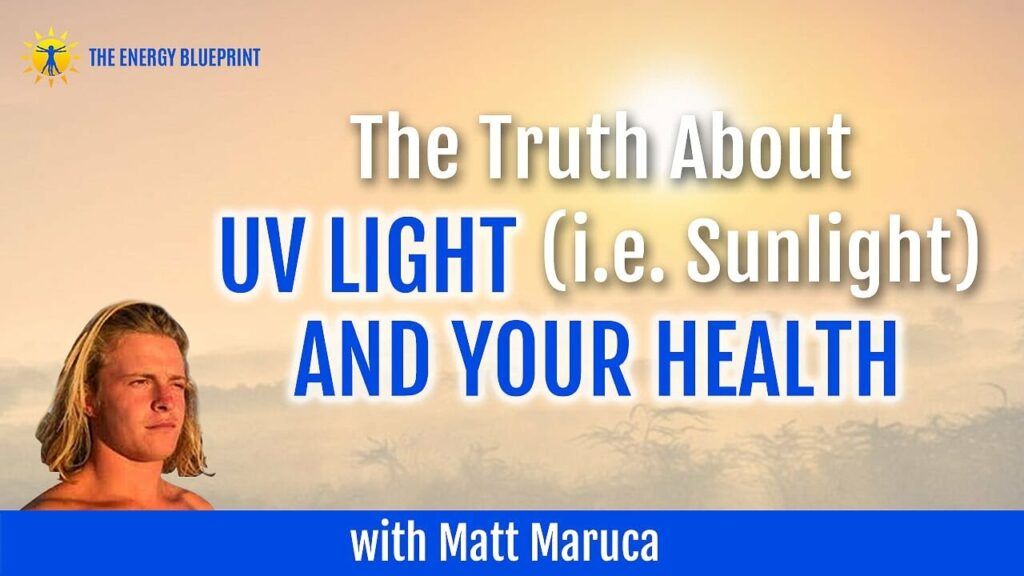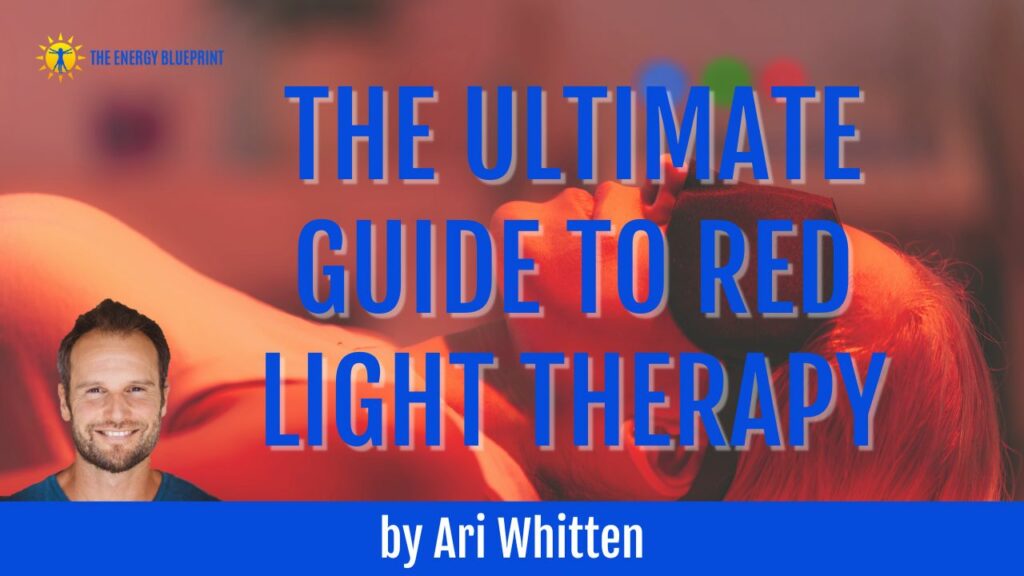
Table of Contents
What if the missing key to achieving your fat loss, anti-aging, and health goals was … light?
Of course, everyone knows about the importance of vitamin D from sunlight (from UV light). But few are aware that there is another type of light that may be just as vital to our health – red and near-infrared light (also referred to as photobiomodulation.)
Think it’s all just hype? Think again! Believe it or not, there are now over 3,000 peer-reviewed scientific studies showing incredible health and anti-aging benefits of red light therapy and near-infrared light therapy, proving that they can help you:
- Fight skin aging, wrinkles, and cellulite and look 10 years younger
- Lose fat (nearly twice as with diet and exercise alone)
- Rid your body of chronic inflammation
- Fight the oxidative damage that drives aging
- Increase strength, endurance, and muscle mass
- Decrease pain
- Combat hair loss
- Build resilience to stress at the cellular level
- Speed up wound/injury healing
- Combat some autoimmune conditions and improve hormonal health
- Optimize your brain function and mood
- Overcome fatigue and improve energy levels
If there was a pill that was proven to have all these effects, it would be hailed as a “miracle drug.” Hundreds of millions of people would be told to start taking it by their doctors every day. And people would tell you that you’re crazy if you weren’t taking it.
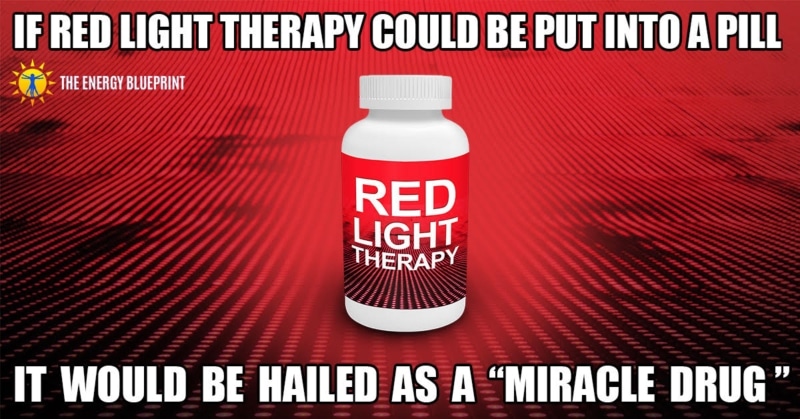
What Is Red Light Therapy And Near-Infrared Light Therapy/Photobiomodulation?
Red and near-infrared light are part of the electromagnetic spectrum, and more specifically, part of the spectrum of light emitted by the sun (and also fire light). These wavelengths of light are “bioactive” in humans. That means that these types of light literally affect the function of our cells.
So what’s all this talk of “electromagnetic spectrum” and “spectrum of light”? Let’s take a look at the electromagnetic spectrum so I can show you more clearly what I’m talking about…
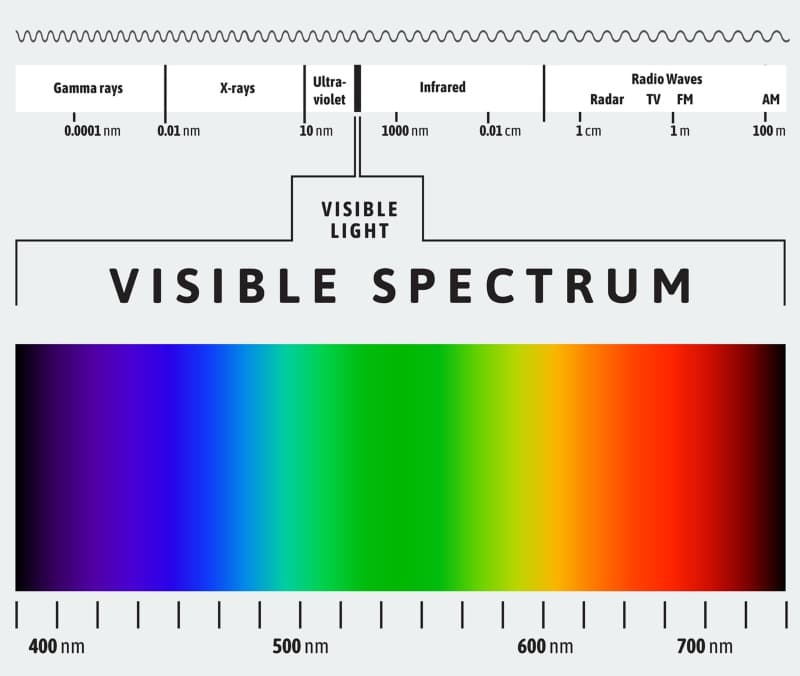
Electromagnetic waves range from 0.0001 nanometer (gamma rays and x-rays are very small waves) all the way to over centimeters and meters (radar and radio waves).
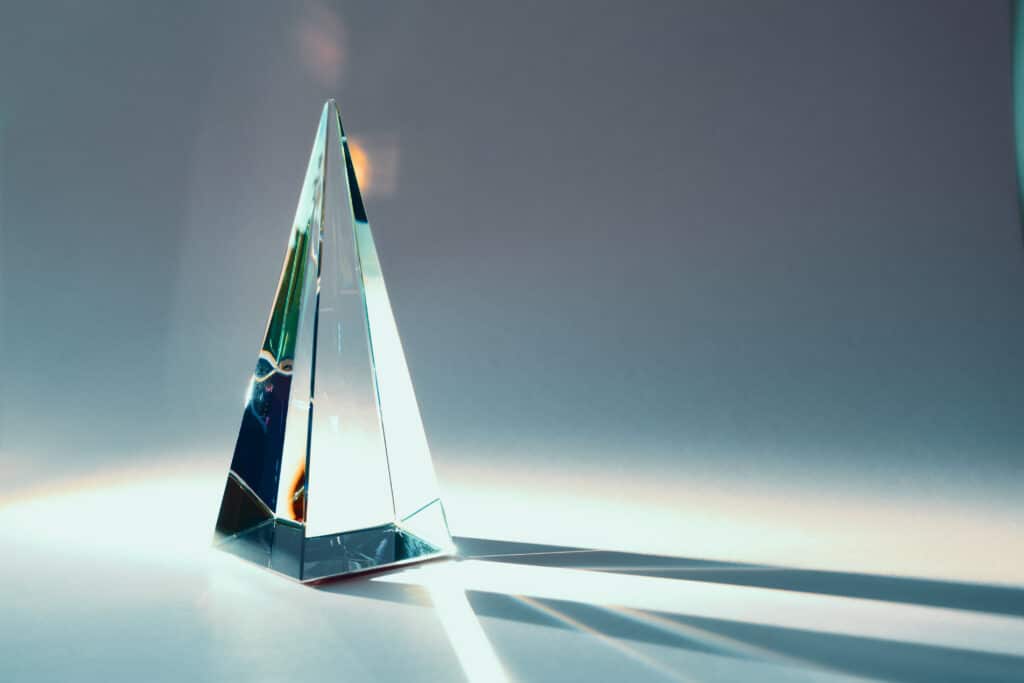
If you pass white light (like sunlight) through a prism, it will separate out the different colors based on their wavelengths. This is how we get rainbows as well, and you might remember this from school with the acronym ROY. G. BIV, which stands for red, orange, yellow, green, blue, indigo, violet.
A tiny part of this spectrum – from roughly 400nm to 700nm – is visible to the human eye.
At the highest end of the visible light spectrum is red light, which goes from a little over 600nm to approximately 700nm. Above the visible light spectrum is near-infrared, from about 700nm to a little over 1,100nm.
It is the red and near-infrared wavelengths specifically that have these amazing effects on our bodies. (Interestingly, even within that range, not all the red and near-infrared wavelengths seem to be created equal. Specifically, most research showing benefits of red light and near-infrared light have used wavelengths in the narrow ranges of 630-680nm and 800-880nm.)
While most other wavelengths of light (such as UV, blue, green, and yellow light, etc.) are mostly unable to penetrate into the body and stay in the layers of the skin, near-infrared light and red light are able to reach deep into the human body (several centimeters, and close to 2 inches, in some cases) and are able to directly penetrate into the cells, tissues, blood, nerves, the brain, and into the bones.
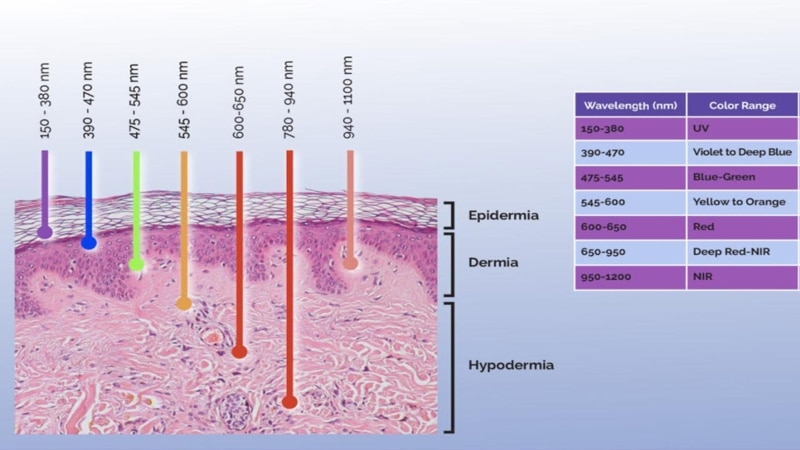
Why Doesn't Everyone Already Know About Near-Infrared and Red Light Therapy? (And Do You Need Lasers To Get The Benefits?)
Two big barriers specifically have hindered the widespread adoption of this technology by the general public:
- Until recently, it was thought that you needed an expensive laser device to obtain these benefits. This technology has been in use in doctor’s offices for many years now and goes by the name of either “low-level laser therapy” (LLLT) or “cold laser.” These red/NIR light laser devices often cost $5,000-$30,000. This is precisely why this technology hasn’t gone mainstream and why most people still haven’t heard of it – because most people are under the impression that you can only get near-infrared and red light therapy from these incredibly expensive laser devices.
- Red and near-infrared therapy LED panels are also being used in anti-aging clinics, where people are being charged $75-$300 per single session to use these lights. This is one of the other barriers – most people believe not only that these lights cost many thousands of dollars, but also that they can only use them by paying hundreds of dollars for a single treatment in a fancy clinic.
Shockingly, new research has shown that it is not necessary to use these expensive laser devices, and most experts now agree that it’s possible to get the same benefits from near-infrared and red light therapy LED panels at a fraction of the cost.
Here’s what Harvard researcher Michael Hamblin, PhD (widely regarded as the world’s top authority on photobiomodulation) has to say on this subject:
“Most of the early work in this field was carried out with various kinds of lasers, and it was thought that laser light had some special characteristics not possessed by light from other light sources such as sunlight, fluorescent or incandescent lamps and now LEDs. However all the studies that have been done comparing lasers to equivalent light sources with similar wavelength and power density of their emission, have found essentially no difference between them.”[1]
So you don’t need a $5,000-$30,000 medical laser device to get these amazing health benefits. You can get these effects with a device that costs just a few hundred dollars.
You don’t have to go to a clinic and pay $75-$300 per treatment. Once you buy one of these devices, you can do unlimited treatments at home for free (or for just the cost of a few minutes of electricity)! You can do light sessions at home with your own light and get all the same benefits while saving yourself the thousands of dollars you would spend at an anti-aging or medical clinic.
As people come to realize that you can get all the amazing benefits of near-infrared and red light therapy without spending $5,000-$30,000 on a laser device or $75-$300 for a single treatment session in an anti-aging clinic, I believe this therapy will go mainstream and nearly everyone will have a red/NIR light therapy device in their home. After all, who wouldn’t want to have a simple-to-use device in their home that can dramatically speed healing, improve hormonal health, accelerate fat loss, increase energy, and combat skin aging?
The Five “Bioactive” Types of Light: Why Humans Need Sunlight to Be Healthy
Just as human cells need nutrients from food, light is also a necessary nutrient for our cells to function well. Certain wavelengths of light can help power up our cells, affect hormones and neurotransmitters, balance our mood, enhance physical performance, hasten recovery from stress, increase alertness, improve sleep, and positively affect the expression of our genes.
The human body needs light to be healthy. Both the right types and the right doses.
This may seem like a strange idea at first, as we’re generally not used to thinking of light as playing an important role in our health. We’re used to thinking of light as what we turn on in our house so we can see, or the headlights of our car that allow us to drive at night. Most of us are deeply unaware of the fact that many different types of light are “bioactive” in humans (which means they affect the functioning of human cells), and that our health is largely influenced by the dosage of these different types of light that we get each day.
These are the five types of bioactive light in humans:
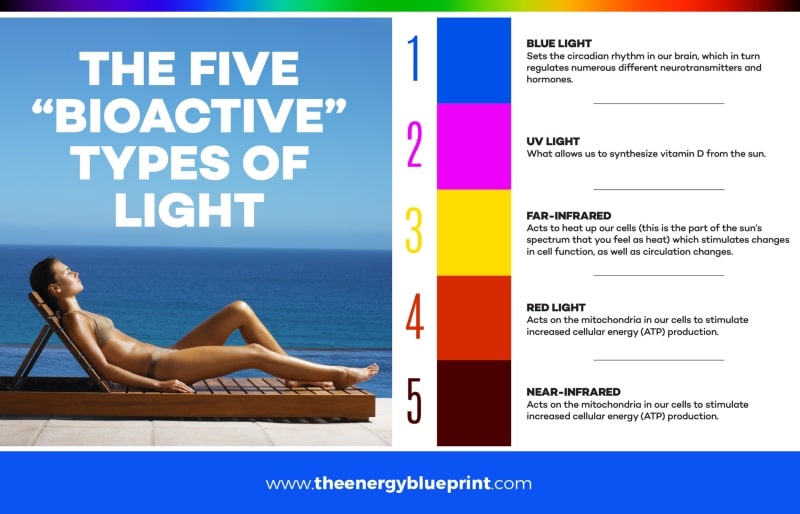
Most modern humans are deficient in the benefits of all of these five wavelengths of light. And just as there are health consequences of not getting enough of the right nutrients in our diet (malnutrition), there are health consequences when we don’t get enough of the right light “nutrients” (mal-illumination).
What kind of health consequences?
Here are two well-known examples of how light deficiencies and imbalances impact human health in profound ways…
Sunlight deficiency and vitamin D deficiency have been linked with numerous diseases, such as:
- Neurodegenerative diseases like Alzheimer’s, dementia, Multiple Sclerosis, and Parkinson’s[3],[4],[5],[6]
- Dozens of types of cancer[7],[8],[9],[10]
- Obesity[11],[12]
- Diabetes[13]
- Metabolic syndrome[14]
- Heart disease[15]
There is even research that suggests that low levels of sun exposure are a risk factor for human health equivalent to that of being a cigarette smoker![16] A Swedish study looked at nearly 30,000 women for 20 years (note: studies with this many people that are this long-term are exceedingly rare) and found that women with the lowest sun exposure had a twofold higher rate of death compared to the women with the most sun exposure![17]
As another example of mal-illumination, artificial light exposure at night (from electronic devices like phones, TVs, computers, indoor lighting, etc.) have been linked with numerous diseases, like:
- Numerous types of cancer[18],[19]
- Depression[20]
- Fat gain, obesity, diabetes and metabolic syndrome[21],[22],[23]
- Insomnia and poor sleep[24]
- Mood disorders[25]
And this is just a few of the dozens of health problems linked to mal-illumination.
But what if I told you that there is another kind of light deficiency that most people are totally unaware of, and that is likely even more problematic?
Near-infrared (NIR) and red light deficiency.
Red and near-infrared light have profound effects on our cellular and hormonal health. And we’re designed to need ample amounts of those types of light to have optimal health.
Just as the modern world of processed food leads to chronic malnutrition, our modern light environment (of too much of the wrong kinds of light and too little of the right kinds, and with poor timing) is called mal-illumination. The vast majority of people living in the modern world are suffering from chronic mal-illumination and don’t even realize it. And it has widespread effects on our brain and organ function, immune system , energy levels, mood, neurotransmitter balance, and hormone levels.
How Does Near-Infrared (NIR) and Red Light Therapy Work?
The next important question to answer is “how the heck does red and near-infrared light actually cause these effects?”
We know how UV light affects us, for example – it works primarily by interacting with our skin and stimulating the production of vitamin D. We also know how blue light enters our eyes and feeds back into the circadian clock in our brain (in the suprachiasmatic nucleus) to regulate our 24-hour biological rhythm, including the complex array of hormones and neurotransmitters that are regulated by this circadian clock in our brain.
These mechanisms are well understood by science. But what about red/NIR light?
There are numerous different physiological and biochemical mechanisms that researchers have identified as being affected by red and near-infrared light, but for our purposes here (since this is not an article meant for academics, but for regular people wanting to benefit from red and near-infrared light), I don’t want to get too bogged down in the details of dozens of different molecular signaling pathways at the cellular level. Instead, I want to keep things as simple and easily understandable as possible.
To give you an idea of what I mean when I say that things can be complex, here is a short list of biochemical pathways that have been proven to be altered by red/near-infrared light:
- Cytochrome c oxidase
- Retrograde mitochondrial signaling
- Light-sensitive ion channels
- Adenosine triphosphate (ATP)
- Cyclic AMP
- Reactive oxygen species (ROS)
- Calcium
- Nitric oxide (NO)
- Nuclear factor kappa B
RANKL - Hypoxia-inducible factor
- Akt/GSK3b/b-catenin pathway
- Akt/mTOR/CyclinD1 pathway
- ERK/FOXM1
- PPARy
- RUNX2
- Transforming growth factor
- Pro- and anti-inflammatory cytokines
- Vascular endothelial growth factor
- Hepatocyte growth factor
- Basic fibroblast growth factor and keratinocyte growth factor
- Heat-shock proteins
- Melatonin
- Brain-derived neurotrophic factor
Rather than talk about the details of dozens of different biochemical pathways, let me simplify the major mechanisms of red/near-infrared light on our body…
Two Key Mechanisms of NIR And Red Light Therapy
I generally think of photobiomodulation as having two central mechanisms in how it benefits cellular function and overall health:
- Stimulating ATP production in the mitochondria through interacting with a photoreceptor called cytochrome c oxidase.
- Creating a temporary, low-dose metabolic stress that ultimately builds up the anti-inflammatory, anti-oxidant and cell defense systems of the cell (known as hormesis, which is also a primary mechanism of why exercise works).
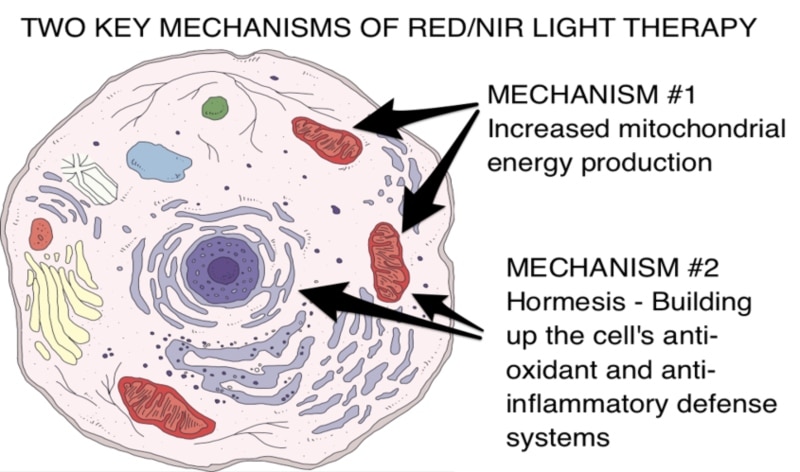
Let’s talk about each of these mechanisms in more detail:
Mechanism #1: Stimulating Mitochondrial Energy Production
Researchers have found that one specific mechanism of near-infrared and red light therapy is that these wavelengths of light are able to penetrate into cells and activate the mitochondria, directly leading to increased cellular energy production. Many lines of research indicate that the mitochondria are the key player when it comes to the mechanism of how red and near-infrared light affect our cells. [26]
This point deserves special attention, because a huge amount of research in the last decade points to the mitochondria as being critical to health, disease prevention, energy levels, and longevity. The mitochondria are the batteries that fuel all the processes of our organs; thus, things which enhance the mitochondria translate into more cellular energy inside the cell, which allows the cell or organ (e.g. brain, heart, liver, skin, muscles, etc.) to work optimally.
When it comes to red/NIR, the photoacceptor cytochrome c oxidase in our mitochondria is of particular importance.
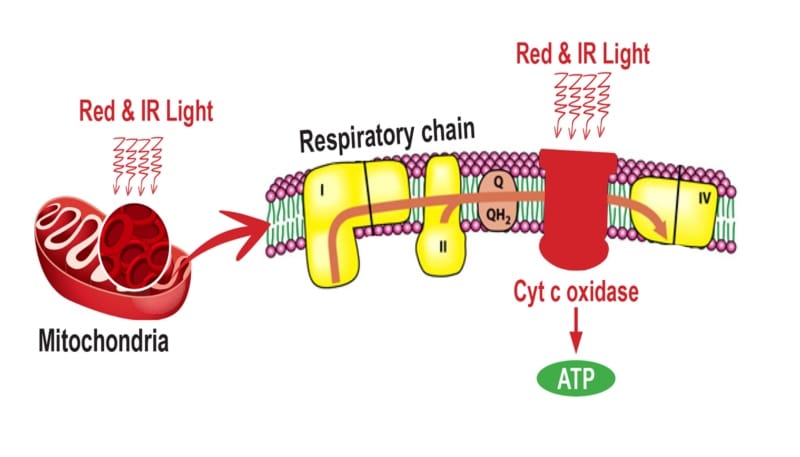
Cytochrome c oxidase is part of the respiratory chain in our mitochondria that is responsible for producing ATP (cellular energy). When red and near-infrared light photons hit the photoacceptor cytochrome c oxidase, it helps the mitochondria use oxygen more efficiently to produce ATP.
While the exact mechanisms are still debated, most researchers believe that nitric oxide (NO) plays a central role.[27],[28]
NO of course plays many vital roles in the body, but when we have too much of it, too much in the wrong place, or when our cells don’t have the antioxidant capacity to quell the buildup of NO, it can hinder ATP from being manufactured in the mitochondria. [29]
How?
Well, nitric oxide begins to compete with oxygen in the mitochondria.
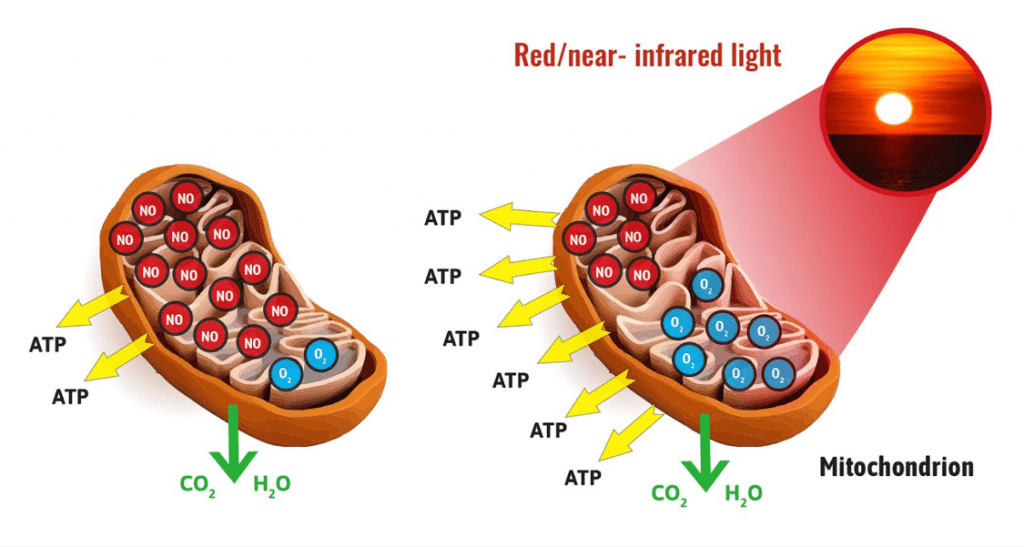
In fact, NO binds with cytochrome c — preventing it from binding with oxygen. It basically blocks the oxygen from being used by the mitochondria. Because of this, the NO inhibits efficient ATP production.
Therefore, in unhealthy cells, nitric oxide prevents cytochrome c from getting enough oxygen molecules. This hinders ATP production, which is a recipe for poor mitochondrial function, and thus, poor cellular function.
As shown by several research groups around the world, red and near-infrared light essentially prevents this pairing of NO with cytochrome c oxidase. It knocks the NO out and lets the oxygen in!
In essence, photobiomodulation allows oxygen into the mitochondria (and prevents NO from halting energy production).[30]
This boosts mitochondrial function and helps improve the health of every organ and system in our body.
Mechanism #2: Hormesis
Another key mechanism for how near-infrared and red light therapy work is through hormesis. Hormesis is the process by which a transient metabolic stressor stimulates adaptations that actually improve health. This may sound like an odd concept at first, but you’re more familiar with it than you realize – exercise is a type of hormesis. Exercise works by transiently creating metabolic stress – stressing out the body (workouts are hard work!) and temporarily increasing reactive oxygen species, a.k.a. free radicals – and then in response to that stress, the body adapts to it with things like improved cardiovascular efficiency, improved blood delivery to the muscles, and by strengthening and growing the mitochondria. It also involves downregulating the genes involved in chronic inflammation and oxidative stress (two keys drivers of aging and disease), and upregulating the genes involved in energy production and the internal cellular antioxidant defense system.
The mitochondria get temporarily stressed in a way that causes them to send signals back to the nucleus of the cell (which contains your DNA), and these signals are literally used by the nucleus to determine what genes should be expressed. This is called “retrograde signaling.” It’s a remarkable phenomenon, because most people think that our genes do all the dictating of what happens in our cells. In fact, mitochondria generate signals (based on the environment) that signal back to the nucleus which genes to switch on and off!
In particular, the transient increases in ROS (free radicals) from red/NIR light activates many of the same cell defense systems that exercise does. The transcription factor NF-kB is activated through exposure to free radicals generated by red and near-infrared light, which promotes a very low level inflammatory response. This then engages a mechanism called the NRF2 pathway and the Antioxidant Response Element (A.R.E.) – our internal cellular antioxidant defense system – which helps put out the fire by eliminating the inflammation and free radicals. In short, in much the same way that exercise builds your muscles stronger by temporarily stressing them, light does the same thing to our internal anti-oxidant and anti-inflammatory defense system. It helps make your cells more tolerant to stress, combats inflammation, helps prevent the buildup of free radicals, and ultimately makes your cells healthier, more energetic, and more resilient.
It turns out that humans actually need some of these low-level stressors in their life. The absence of these stressors actually sabotages our health.
Light serves a transient low-level stress to your cells. The end result of these cellular adaptations to the temporary stress is healthier cells that produce more energy, have a stronger anti-oxidant and anti-inflammatory defense system, and are more resilient to overall stress.
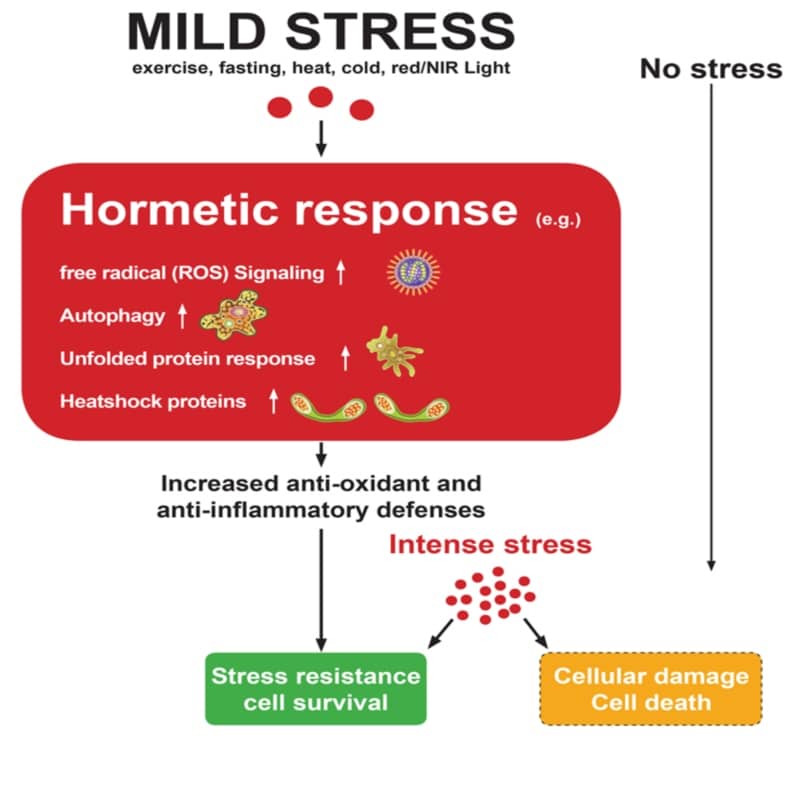
In this way, red/NIR light become a powerful tool that doesn’t just temporarily alleviate symptoms (like say, an anti-inflammatory or painkiller drug), but it stimulates your body making lasting adaptations at the cellular level that lead to more resilience against stressors and a greater capacity to produce energy.
Mechanisms Summary
As mentioned above in the list of factors known to be affected by red/NIR light, there are also many other mechanisms of action of photobiomodulation which researchers are still elucidating. It is likely that other effects on specific compounds (e.g. BDNF, cAMP, nitric oxide, etc.), on stem cells,[36] on hormones,[37],[38] DNA repair,[39] or some other specific effects on gene expression[40],[41],[42] also play a role in mediating many of the positive effects of red/NIR light therapy.
The truth is that it’s possible to get endlessly complex and nuanced about all the different molecular and biochemical pathways involved. But again, to simplify all this…
In essence, what this all boils down to is that near-infrared and red light therapy help mitochondria produce more energy, decrease inflammation, and help build the cell defense systems to increase resiliency.
Thus, the reason it can benefit so many radically different health issues is actually quite simple: The health of every organ and every cell in the body depends on the energy being produced by the mitochondria in those cells. Thus, because red/NIR light therapy work to enhance mitochondrial energy production in essentially every type of cell in the body, it can enhance the cellular processes and cellular health of potentially almost every type of cell in the body.
Benefits of Red Light Therapy
1. Near-Infrared and Red Light Therapy For Skin

Because red light stimulates both collagen and elastin production, dramatically reduces lines and wrinkles, as well as the appearance of scars, surface varicose veins, acne, and cellulite, photobiomodulation is fast becoming recognized as a safe and welcome alternative to injections and surgeries for anti-aging and skin rejuvenation.
Repairing damage from UV rays requires that skin be able to repair cellular and DNA damage, much as it does when healing from wounds. Red light does this extremely well through stimulating collagen synthesis and fibroblast formation, anti-inflammatory action, stimulation of energy production in mitochondria, and even stimulating DNA repair.[44]
A wealth of human studies is proving photobiomodulation can reverse the signs of aging, repair damage from UV rays, and reduce the appearance of lines, wrinkles, and even hard to remove scars. A 2013 issue of Seminars in Cutaneous Medicine and Surgery featured a review of the research that highlighted dozens of studies proving photobiomodulation can reduce the signs of aging.[45]
Another review of the research by Harvard professor Michael Hamblin, PhD has found that red and near-infrared light therapy can:
- reduce the signs of damage, DNA damage, [46] and aging from UV rays[47]
- reduce wrinkles[48]
- reduce color patches, hyperpigmentation, and skin discoloration[49]
- enhance collagen synthesis and collagen density (research has shown it can enhance production of collagen by 31%)[50],[51]
- accelerate repair in the epithelial layer of skin[52]
- combat other skin conditions like acne, keloids, vitiligo, burns, herpes virus sores, and psoriasis[53]
- speed wound healing by enhancing skin tissue repair and growth of skin cells[54]
In short, photobiomodulation is offering a new, extremely safe and non-invasive alternative to various anti-aging skin surgeries, Botox injections, and more abrasive chemical peels. For combating skin aging, red and near-infrared light is an extraordinarily powerful tool.
2. Near-Infrared and Red Light Therapy For Hair Loss and Growth
Red light has also been shown to help with certain types of hair loss. Red light has proven to help both women and men with various conditions to regrow hair and even thicken the diameter of individual hair strands. Near-infrared and red light therapy has proven to help women with alopecia to significantly regrow and thicken hair.[55]
3. Near-Infrared And Red Light Therapy For Cellulite
One study found that when photobiomodulation is combined with massage, it led to an astounding 71% reduction in cellulite![61]
Another study that assessed the use of near-infrared and red light therapy on skin health found that “91% of subjects reported improved skin tone, and 82% reported enhanced smoothness of skin in the treatment area.”[62]
4. Photobiomodulation For Wound Healing
Near-infrared and red light therapy are fantastic for wound healing. Red/infrared light accomplishes this in several ways:
- cleaning up dead and damaged cells in skin (phagocytosis)
- increasing ATP in skin cells, giving cells more energy to heal themselves
- increasing the production of fibroblasts[64],[65]
- increasing blood flow, supplying the wound more oxygen and nutrients needed for repair
- stimulating the production of collagen and the health of the extracellular matrix[66]
- stimulating lymph activity
- stimulating the formation of new connective tissue and blood capillaries on the surface of the wound. [67],[68],[69],[70],[71],[72],[73]
5. Near-Infrared And Red Light Therapy For Fibromyalgia, Chronic Fatigue, and More Energy
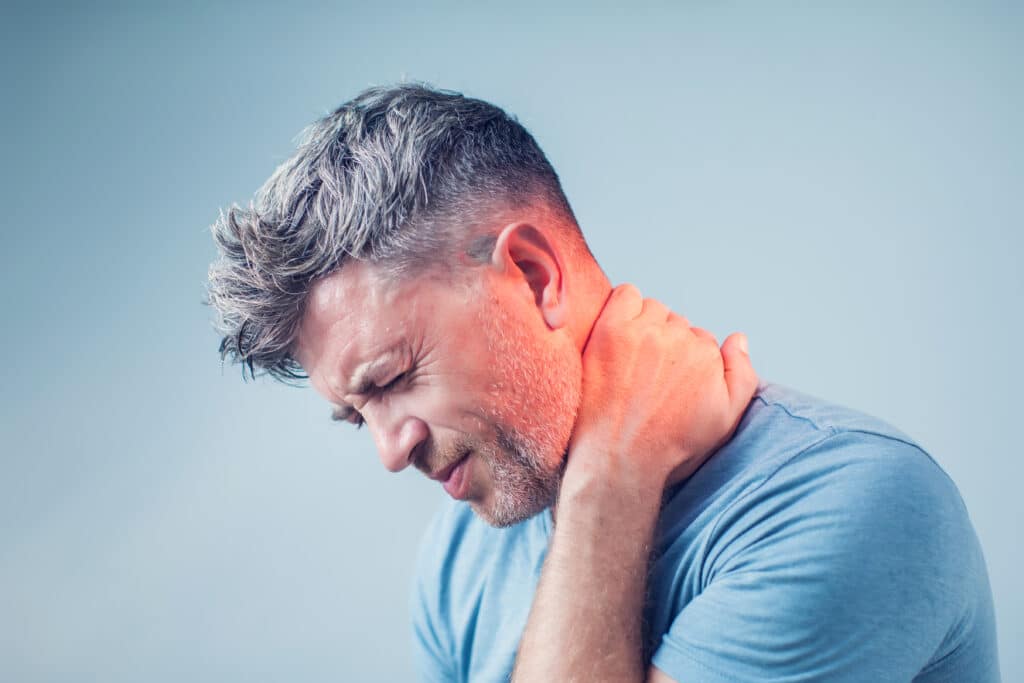
Studies show that red light therapy is also effective at restoring energy and vitality in persons suffering with fibromyalgia. Multiple studies have found that photobiomodulation offers:
- Enhanced quality of life for fibromyalgia patients
- Decreased pain
- Decreased muscle spasm
- Decreased morning stiffness
- Decreased total tender point number in fibromyalgia cases
Research – including a very recent 2017 study – suggests that this therapy method is a safe and effective treatment for fibromyalgia.[76],[77],[78]
6. Near-Infrared and Red Light Therapy For Hashimoto's Hypothyroidism
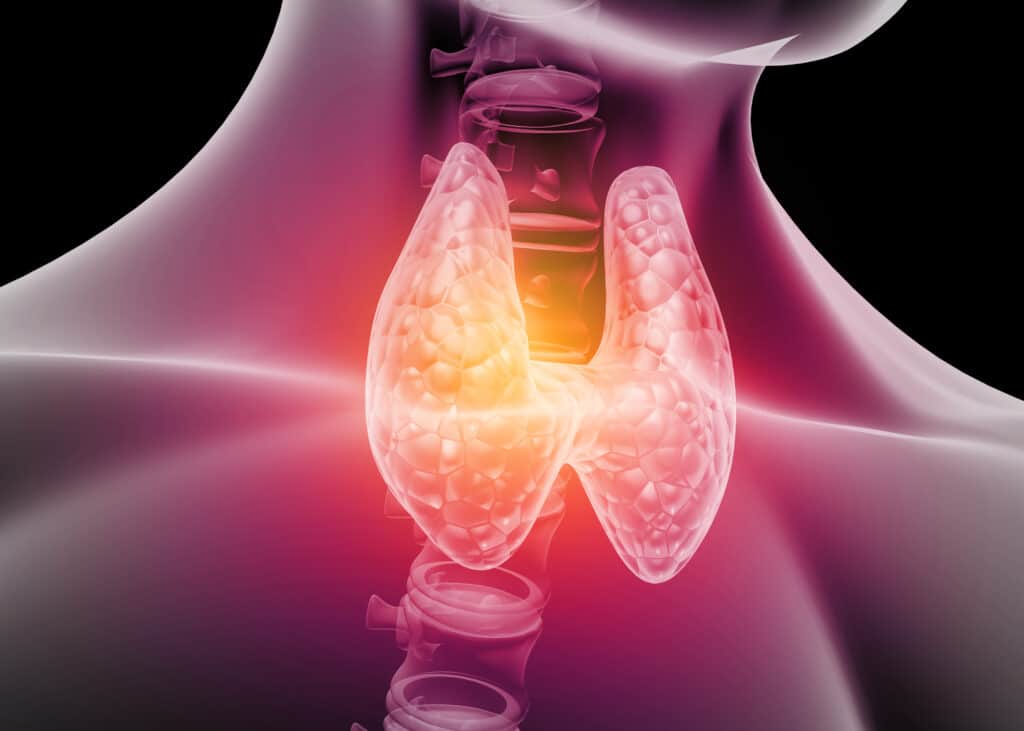
Several studies have shown profound benefits of photobiomodulation for autoimmune hypothyroidism.
- A recent 2013 randomized, placebo-controlled study in hypothyroid patients demonstrated that in people who got near-infrared light therapy, thyroid function dramatically improved, and remarkably, that thyroid antibody (TPOAb) levels were massively reduced. Amazingly, 47% of patients were able to stop medication completely! Moreover, the researchers also followed up 9 months after treatment and found that the effects were still evident![85] They even published a 6-year follow-up, which basically said that even at 6 years, some of the benefits still remained, but periodic sessions were recommended to maintain all benefits.[86]
(To be honest, I don’t suggest red/NIR light as a one-time treatment that is expected to last long-term. For optimal benefits, most research indicates that sessions be done with red/NIR therapy at least once a week consistently.)
- A 2010 study found that photobiomodulation helped 38 %of study participants reduce their hypothyroid medication dose, with a whopping 17% being able to stop taking the medication altogether![87]
- A 1997 study done in Russia included some data on people with autoimmune hypothyroidism who underwent a thyroid surgery. They found that red/NIR light therapy improved thyroid hormone levels enough that they required, on average, roughly half as much thyroid hormone medication.[88]
- A 2003 study done in the Ukraine showed that red light therapy can decrease thyroid medication needs by 50-75% in people with postsurgical hypothyroidism.[89]
- A 2010 Russian dissertation study gave red light therapy on the thyroid gland to a group of people with hypothyroidism and found that 17% of people could completely get off thyroid medication and 38% could decrease the dose by 25-50µg.[90]
- A 2014 study used the light therapy for 10 sessions with 347 women with subclinical hypothyroidism. At baseline, the average TSH (thyroid stimulating hormone) was 9.1 mIU/L. (Note: Higher TSH is a sign of hypothyroidism). After ten sessions of light therapy, the TSH was normalized in 337 (97%) of these women. Their TSH averaged at 2.2 mIU/L after just 10 light treatments.[91]
7. Improve Bone Health with Photobiomodulation
Studies on animals and humans have found that red and near-infrared light therapy greatly aids in healing breaks, fractures, and bone defects.[103] ATP production is interrupted in broken bones, and cells begin to die from lack of energy. Red and near-infrared light have been shown toStimulate energy production in the bone cells[104]
- Increase bone growth factors[105]
- Enhance blood vessel formation and blood flow to the affected area[106]
- Modulate inflammation[107]
- Enhance the attachment and production of collagen and procollagen and stimulates growth of bone cells – all of which accelerate the bone repair process[108],[109]
Overall, bone irradiated with near-infrared wavelengths shows increased bone formation and collagen deposition.[110] Photobiomodulation is becoming very popular in all sports where breaks, sprains, and fractures are frequent — from horse racing to football.
8. Near-Infrared and Red Light Therapy For Inflammation (and Potentially Inflammation-Related Diseases)
Red and near-infrared light therapy is highly effective in treating chronic inflammation.
Since chronic inflammation is now being recognized as a major contributor to most chronic diseases from heart disease, depression, and cancer, to Alzheimer’s and chronic fatigue syndrome, this effect of red light therapy on inflammation is a very big deal.
Many aging scientists now speak of “inflamm-aging”[111] — the concept that the genes and pathways that control inflammation may very well be the key drivers of aging and disease.
Studies have even shown that red/NIR light therapy can have anti-inflammatory effects on par with non-steroidal anti-inflammatory drugs (NSAIDs),[115] which are the anti-inflammatory drugs routinely prescribed and typically, the over-the-counter drugs people buy when in pain.
9. Improve Eye Health with Near-Infrared and Red Light Therapy
Research into the benefits of near-infrared and red light therapy for eye health is very promising. Studies on animals show that photobiomodulation can heal damage to eyes from excessive bright light in the retina. This kind of damage is similar to the damage that occurs in age-related macular degeneration (AMD).[116]
One human study in patients with AMD showed that red light therapy improved vision and that improvements were maintained for 3-36 months after treatment. It also appeared to improve edema, bleeding, metamorphosia, scotoma and dyschromatopsia in some patients.[117]
Note: The eyes are sensitive tissues, and as such, for any self-use of light therapy, I suggest shorter sessions at an increased distance away from the light. And as always, for any medical conditions, consult your physician rather than attempting to self-treat.
10. Near-Infrared And Red Light Therapy For Anxiety And Depression
A 2009 study took 10 patients with a history of major depression and anxiety (including PTSD and drug abuse) and gave them four weeks of treatments to the forehead with red/NIR light. Remarkably, by the end of the four-week study, 6 out of 10 patients experienced a remission of their depression, and 7 out of 10 patients experienced a remission of their anxiety.”[122]
Though further research is needed, there have been 10 studies so far on the use of photobiomodulation to treat depression and anxiety related disorders with 9 of 10 studies yielding very positive results.[123],[124],[125],[126],[127],[128],[129],[130]
11. Improve Cognitive Performance with Photobiomodulation
In studies, researchers have found that transcranial near-infrared and red light therapy profoundly benefits the brain and cognitive performance.[132] Research has also shown that transcranial near-infrared stimulation has been found to increase neurocognitive function in young healthy adults,[133] finding that it improved sustained attention and short-term memory retrieval in young adults, and improved memory in older adults with significant memory impairment at risk for cognitive decline.[134]
Another study found photobiomodulation also increased executive cognitive function in young healthy adults, providing hope that further studies find that near-infrared and red light therapy may provide a hopeful treatment in the fight against Alzheimer’s disease, as well as prevention.[135]
12. Near-Infrared and Red Light Therapy for Tendonitis
One of the most common uses for red and near-infrared therapy in clinics is for injuries and tendonitis. Because red light stimulates collagen production, speeds wound healing, and is highly anti-inflammatory, it has been shown to bring great relief to people suffering from tendinopathy and tendonitis. [136],[137]
A systematic review of the research concludes that photobiomodulation has proven highly effective in treating tendon disorders in all 12 studies conducted.[138]
13. Increase Fertility with Near-Infrared and Red Light Therapy

Some research suggests that red light therapy may be useful for fertility, which is making quite an impact upon couples trying to conceive.
It also improves follicular health, which are highly vulnerable to oxidative stress. Two recent studies, one in Japan and one in Denmark, found that photobiomodulation improved pregnancy rates where IVF had previously failed, in Denmark, by 68%.[140]
In Japan, near-infrared and red light therapy resulted in pregnancy for 22.3% of severely infertile women with 50.1% successful live births.[141]
As mentioned previously, the testicles also have photoreceptors that respond to red light, and research shows that photobiomodulation can greatly enhance sperm motility and therefore, fertility.[142],[143]
In studies on human sperm, near-infrared light therapy at 830 nm produced significant improvements in sperm motility.[144]
Note: Some people have made some claims around the capacity ofphotobiomodulation to increase testosterone levels. While I was initially excited about this, upon exploring the research that was cited in support of this, I have concluded that the evidence is simply not strong enough to support these claims. The claims are based mostly on one study in rats, which wasn’t an impressive study – it only showed elevations in testosterone briefly on one day, before returning to normal.[145] It also didn’t show testosterone elevation for the group using near-infrared (only in the group using red light). The study did use very high doses (far too high, in my opinion) and it’s possible that a more reasonable dose could lead to benefits for testosterone levels. However, other studies have failed to show similar benefits. [146],[147] I remain open to the possibility that red/NIR light may increase testosterone levels when used on the testes, but the evidence for it as of this writing (2018) is not sufficient. That said, there is some intriguing research on the ability of sun exposure and vitamin D to boost testosterone levels, and that seems a safer bet for now.[148],[149]
While the research on boosting testosterone is not strong, there is an abundance of solid evidence for the ability of red/NIR light therapy to improve fertility.
14. Near-Infrared and Red Light Therapy For Arthritis and Joint Health
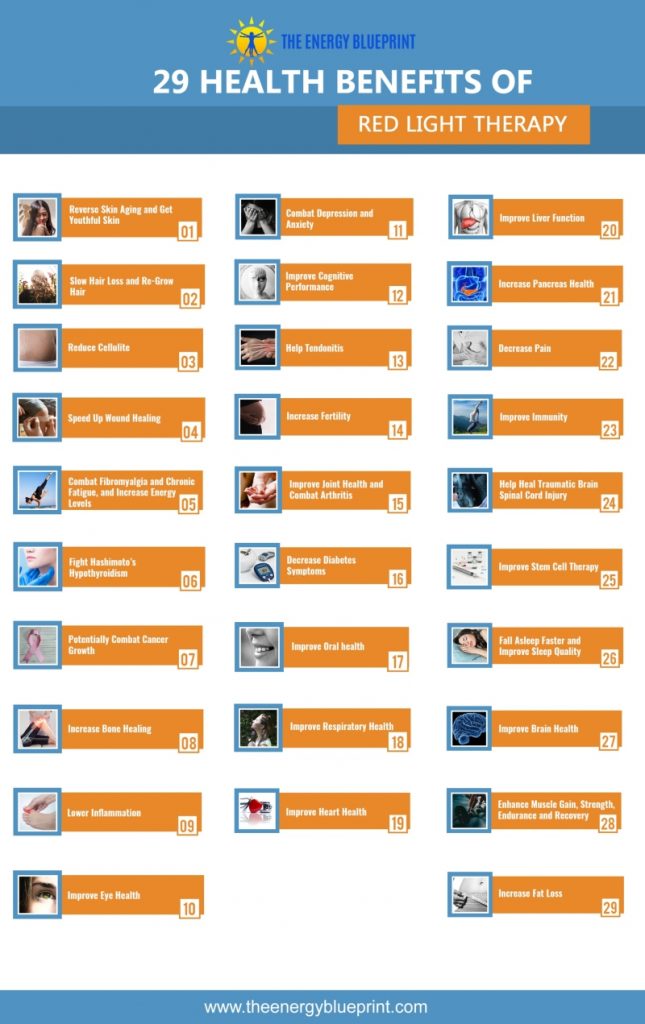
15. Decrease Diabetes Symptoms with Photobiomodulation
For diabetics, the most positive results gleaned from studies on the effects of near-infrared and red light therapy for healing is healing foot ulcers. Historically, these are harder to heal due to poor circulation and high glucose levels, especially in the lower limbs. Studies in animals and humans reveal that photobiomodulation restores diabetic patients’ normal healing ability by exerting a stimulatory effect on the mitochondria with a resulting increase in adenosine triphosphate (ATP).[158],[159],[160],[161]
Red light therapy also has had profound success in helping patients with painful diabetic neuropathy. Studies have found that photobiomodulation also helps to relieve pain and improve nerve function and foot skin microcirculation in diabetic patients.[162],[163],[164],[165]
(Another way to reduce foot ulcers is to do Hyperbaric Oxygen Therapy (HBOT) Listen in, as Dr. Scott Sherr shares his expertise on HBOT and how it relates to diabetics with foot ulcers.)
16. Near-Infrared and Red Light Therapy For Oral Health
Red light therapy and near-infrared light therapy have proven to have numerous benefits for oral health and research in this area is booming right now. So far, studies indicate promising results for photobiomodulation, which has been shown to:
- Combat viral and bacterial infections of the mouth (tonsillitis, herpes, cold sores)[166],[167],[168]
- Reduce mouth pain[169]
- Facilitate tooth growth/tooth movement and reduce pain for individuals with corrective braces[170],[171],[172]
- Help diabetics with gum problems and periodontal disease[173],[174],[175]
- Reduce thrush (yeast in the mouth/candidiasis)[176],[177]
- Improve tooth sensitivity[178],[179]
- Fight gum disease and gingivitis[180],[181],[182]
17. Improve Respiratory Health with Near-Infrared and Red Light Therapy
18. Red And Near-Infrared Light Therapy For Pain Relief
Near-infrared and red light therapy has been remarkably effective at reducing joint pain in virtually all areas of the body.
Here are several conditions where red/NIR light has proven effective:
19. Use Photobiomodulation To Improve Immune System Function
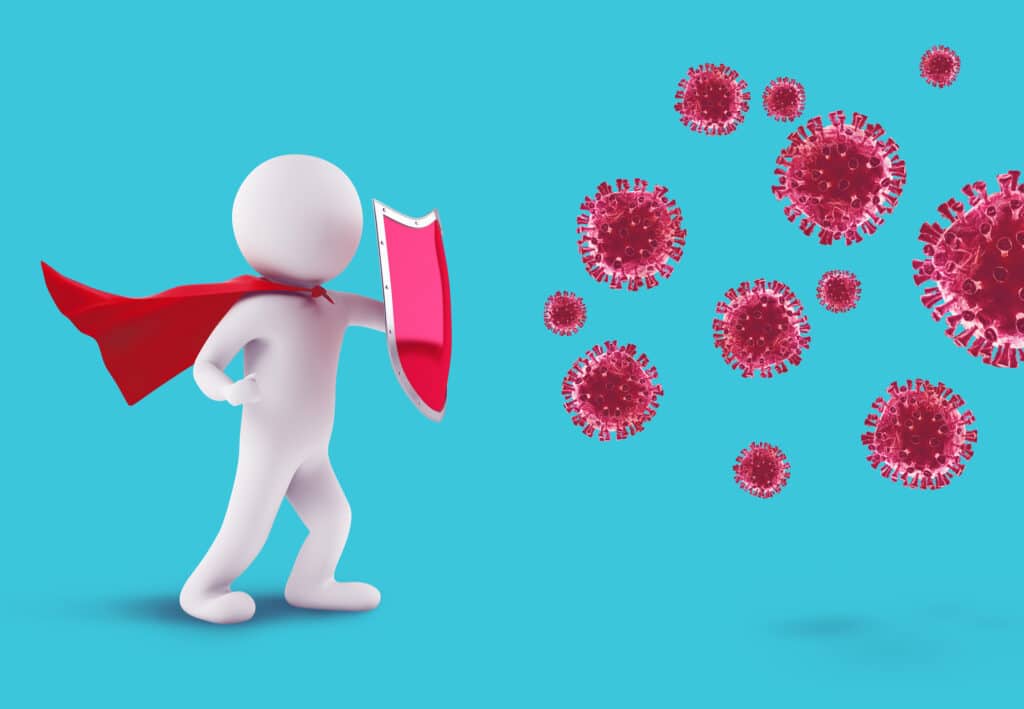
In numerous studies, red/NIR light therapy has proven to benefit the immune system.
- In animal studies, near-infrared and red light therapy has a boosting effect on the immune system of immune-deficient cancer-inoculated animals, resulting in an increased lifespan.[216]
- In human studies, photobiomodulation also boosted the immune systems and T cells of preoperative cancer patients without increasing tumor size. [217]
- In the context of wound healing, it has also been shown to have beneficial effects, in part by modulating immune function.[218]
- Another study found that red/NIR light therapy to the bone marrow could increase the platelet count and help resolve low blood platelets caused by chemotherapy or by an autoimmune disease.[219],[220]
- It also appears to selectively modulate cell function in some types of infected cells while not affecting healthy uninfected cells in the same way.[221]
- In vitro studies on human leukocytes have shown that near-infrared light can increase activity of these immune cells. Given that we know red/NIR light penetrates our blood vessels and irradiates our bloodstream, it is reasonable to think may also happen internally.[222],[223]
- A fascinating study in mice looked at shining red light on the thymus gland (an important gland in the immune system) and on an area of a back leg. They found that the mice who received the treatment on the thymus gland area (in the center of the chest) had more profound changes in immune cell function.[224]
- Another remarkable and more recent study from December 2017 suggests that red/NIR light may be able to slow or even reverse this “thymic involution” – thus keeping our thymus gland function and immune function in tact as we age.[225]
- As discussed in the section on thyroid health, in people with Hashimoto’s – a common autoimmune condition responsible for most hypothyroidism – red/NIR light has proven to have remarkably beneficial effects on immune function.[228] Another animal model of multiple sclerosis (another autoimmune condition that degenerates the fatty sheath around nerves that helps nerve conduction) showed that just two treatments done over a span of 14 days led to significant improvement with less brain cell death and slowed the progression of the disease.[229] Other animal studies have found similar effects.[230]
Overall, red/NIR light seems to be an “immune nutrient” that supports optimal immune function in a wide variety of different scenarios and health conditions. It seems to be able to positively affect immune function in the right direction, potentially, regardless of whether someone has low immune function during an infection or has an overly active and imbalanced immune system due to autoimmune disease.
20. Red Light Therapy For Traumatic Brain Injury (TBI) and Spinal Cord Injury
Red light therapy is bringing recovery and enhanced cognition to those suffering from traumatic brain injury. Patients who have suffered TBI report improved cognition, better sleep, and enhanced recovery from the traumatic experience of their accident.[231],[232]
In animal research, photobiomodulation has impressive outcomes in recovery of animals after stroke. Scientists believe the therapeutic effects stem largely from increased mitochondrial function (i.e. increased ATP production) in brain cells irradiated with near-infrared and red light therapy.[233],[234],[235]
Spinal cord injuries cause severe damage to the central nervous system with no effective known restorative therapies. However, near-infrared and red light therapy has been found to accelerate regeneration of the injured peripheral nerve and increase the axonal number and distance of nerve axon regrowth, while significantly improving aspects of function toward normal levels. Numerous studies indicate that near-infrared and red light therapy is a promising treatment for spinal cord injury that warrants full investigation.[236],[237],[238],[239]
21. Near-Infrared and Red Light Therapy For Sleep (Improve Your Sleep Quality)
Several studies in China have found that red/NIR light exposure, and studies have also found dramatic benefit to sleep in people with insomnia.[260],[261],[262]
- The first documented use of a similar intranasal light therapy device to directly observe melatonin level was conducted by Xu C et al in 2001. They treated 38 subjects that had insomnia with intranasal low level laser therapy once a day over 10 days. They found that serum melatonin had increased.
- The same group of researchers further treated another group of 128 patients with insomnia and found that the polysomnogram (sleep study that includes data on brain waves as electrical activity) data had improved.
- In 2006, Wang F et al reported that they had treated 50 patients with insomnia with intranasal low level laser therapy that is of similar specifications to Vielight’s laser device for 60 minutes per session. Each session was conducted once a day over between 10 to 14 days. They found that the condition had improved significantly in 41 (82%) of the cases, mild for 4 (8%) of the cases, and none for 5 (10%) of the cases.
- Traditional Chinese Medicine practitioners often prescribe herbs as remedy for insomnia. This seems to help somewhat. Chen YM et al tested 90 patients and found that that the condition improved significantly for 40% of the cases, mild for 37.5% and none for 22.5% of the cases. In the group that added the extra element of the intranasal low level laser therapy, the improvement in the number of positive results were significantly more impressive. 78% of the patients experienced significant improvement, 20% mild and 2% none.[263],[264],[265],[266]
22. Near-Infrared And Red Light Therapy For Brain Health (Slow Progression of Alzheimer’s and Parkinson’s Disease)
Recent studies have now found that photobiomodulation may significantly slow the progression of Alzheimer’s and Parkinson’s disease.[280],[281]
Red and near-infrared light have been shown to:[275],[276],[277],[278],[279]
- Benefit cognitive performance and memory
- Improved mitochondrial function of brain cells
- Have a protective effect on neurons
- Improve cellular repair of neurons
- Increase brain-derived neurotrophic factor (BDNF) and nerve growth factor (NGF)
- Decrease brain inflammation (decreased pro-inflammatory cytokines and increased anti-inflammatory cytokines)
23. Use Photobiomodulation To Enhance Muscle Gain, Strength, Endurance, and Recovery
“In the near future, sport agencies must deal with ‘laser doping’ by at least openly discussing it because the aforementioned beneficial effects and the pre-conditioning achieved by laser and LED irradiation will highly improve athletic performance.” [286]
– Michael Hamblin, PhD
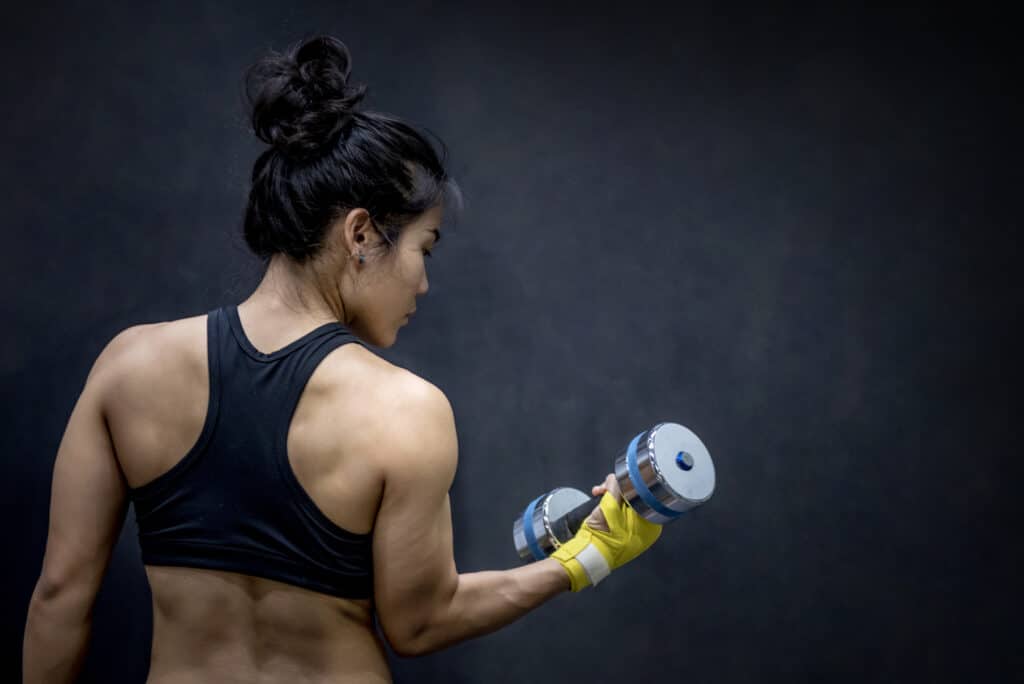
Red/NIR light with exercise makes a potent combination. Not only does red/NIR light help you recover faster, it seems to amplify everything that happens with exercise – increased muscle gain, fat loss, performance, strength, and endurance.
Muscle tissue has more mitochondria than almost any other tissue or organ in the human body. So muscle tissue is particularly responsive to photobiomodulation. The muscles are packed with mitochondria, because ATP is needed for every muscle twitch and movement, no matter how insignificant.
Through their effect on ATP production and cellular healing mechanisms, red/NIR light help individuals to recover more quickly from strenuous and resistance exercise, and even helps to prevent muscle fatigue during exercise.[292]
Studies provide evidence that near-infrared and red light therapy powerfully help prevent muscle fatigue, enhance muscle strength and endurance, increase fat loss responses from exercise, increase muscle growth responses from exercise, and promote faster recovery.[293],[294],[295],[296],[297],[298],[299],[300],[301]
To get into just a few of the dozens of studies on this topic:
- One study by Vieira et al. examined levels of fatigue in leg muscles after endurance exercise and found that using light therapy immediately following significantly reduced fatigue scores relative to the control group. The researchers concluded “The results suggest that an endurance training program combined with LLLT leads to a greater reduction in fatigue than an endurance training program without LLLT. This is relevant to everyone involved in sport and rehabilitation.”[310]
- Leal-Junior et al. performed a review of the relevant research in 2015 to examine the effects of phototherapy on exercise performance and recovery. They compiled data from thirteen randomized control trials and examined the number of repetitions and time until exhaustion for muscle performance, as well as markers of exercise-induced muscle damage. The researchers concluded that pre-conditioning the muscles with red/NIR light (i.e. using the light prior to exercise) significantly improves muscular performance and accelerates recovery.[311]
- Another study looked at use of LED red/NIR therapy lights in male athletes who performed 3 intense bouts of exercise on a stationary bike. The athletes who were given the LED light therapy prior to the exercise had significantly lower levels of creatine kinase (a marker for muscle damage) compared to the sham light therapy (placebo) group.[312]
- A recent 2016 review of 16 studies by Nampo et al.[313] looked at research using both laser and LED therapy on exercise capacity and muscle performance of people undergoing exercise compared to placebo/sham treatments. They found an average improvement of 3.51 reps, a 4 second delay in time to exhaustion (i.e. people were able to exercise longer before exhaustion), increased peak strength, and a significant reduction in lactic acid production.
- A review of research by Borsa et al. found that studies consistently show that red/NIR light done prior to weight training improved performance and decreased muscle damage.[314]
- Another study compared red/NIR light therapy with LEDs to cold water immersion (e.g. ice baths) as a recovery method after exercise and found that red/NIR light improved recovery more than ice baths.[316]
- A 2015 study by Baroni et al. [317] looked at 30 healthy males who were randomized into 3 groups:
- Control group – remained sedentary
- Training group (TG) – did an 8-week exercise program
- Training + light therapy (TLG) – did the same 8-week exercise program plus also did a light treatment using a near-infrared light (810nm wavelength) before each training session.
What happened?
- The training group improved strength by about an average of 14% while the group that included light therapy improved by nearly 25%.[318]
- The training group improved muscle size of the quadriceps muscles by about 10% while the group that included light therapy nearly doubled that improvement! [319]
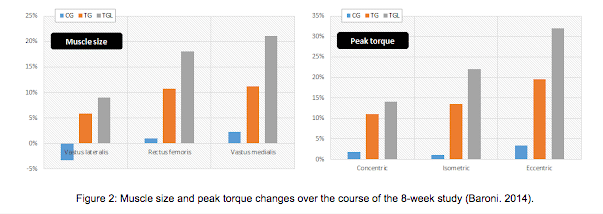
As you can see, red and near-infrared light also have the ability to increase your strength and endurance adaptations to exercise, decrease muscle damage from your workouts, help you recover faster, and even increase muscle gains.
24. Red Light Therapy For Weight Loss (And Help Burn Off Stubborn Fat)
Research has shown that photobiomodulation has a profound impact on reducing fat mass and fat tissue, and at eliminating cellulite. Red light therapy devices have even been approved by the FDA for fat reduction.
In studies, near-infrared and red light therapy have helped shave an entire 3.5 to 5.17 inches off waist and hip circumference by reducing the fat mass layer in just four weeks of use. [321],[322]
In another study of 86 individuals using red light therapy at 635 nm for 20 minutes every other day for two weeks, study participants lost 2.99 inches across all body parts — yes, 3 inches — in just 14 days of photobiomodulation.[324]
That said, I am not a strong advocate of trying to use red/NIR light therapy alone to cause fat loss. Where I believe red/NIR light therapy really shine (forgive the pun) is when combined with exercise and a good diet.
Some research shows that photobiomodulation can dramatically enhance — nearly double — fat loss from exercise, as compared to people doing just the exercise routine without the NIR light therapy.[325] In addition, the group using the NIR light therapy in tandem with exercise saw nearly double the improvements in insulin resistance![326]
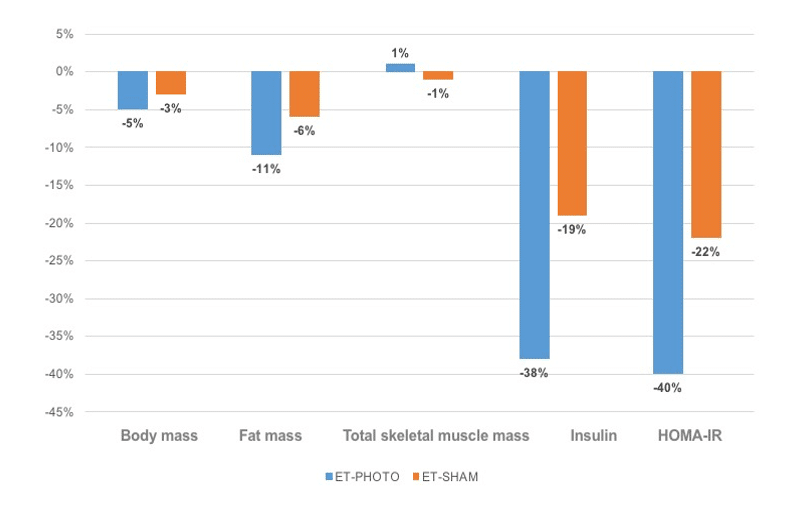
(Image source: Suppversity). The above graph shows the differences in reductions in body weight, body fat, insulin levels, and insulin resistance (IR) from either NIR light therapy (ET-PHOTO) vs. sham/placebo light therapy (ET-SHAM). As you can see, exercising with NIR light nearly doubled the loss of body fat and nearly doubled the improvement in insulin resistance.
Again, please note that red/NIR light therapy doesn’t actually burn off the fat by itself. The mechanism appears to be that it causes the fat cells to release their stored fat into the bloodstream where it can (potentially) be burned for energy. One still must be in a calorie deficit to have actual fat loss. Your overall diet and lifestyle must be conducive to overall net fat loss, otherwise you will just put back the fat right back into the fat cells it was released from. If you’re not actively doing nutrition and lifestyle interventions to lose fat, please don’t think that the light therapy alone will cause fat loss. Think of it more as a tool to amplify the fat loss effects from diet and exercise, rather than a tool that generates fat loss by itself. Nevertheless, this technology can be used to greatly accelerate loss of overall body fat, and even “stubborn fat” from fat areas that normally are resistant to being burned off – for men, this is the lower abdomen and love handles, and for women, the hips and thighs most typically, or belly fat.
Overall, the research is clear that red/NIR light can be a powerful tool to support your fat loss efforts.
Photobiomodulation Dosing Guide
If you want an effective light therapy session, you must have an effective dose. That requires:
- A light that is relatively powerful (i.e. has an ideal “power density”)
- Ideally, a light that can treat a large area of the body at once
- An understanding of the optimal duration of time using the light to get the right total dose
Too little of a dose and you get minimal to no effects. Too strong of a dose and you get minimal to no effects.
Let’s talk about power density of the light first.
Most studies showing benefits of red/NIR light therapy used light outputs of 20-200mW/cm2.
This is basically a measurement of power density – how much power the light is emitting (in watts) over how big of an area.
To put that in different terms, if you shine the light on your torso (let’s say, for the sake of ease of calculation, that it’s an area of 50cm x 40cm, which equals 2,000cm2)…
And the light you’re using is 200 watts (which is 200,000mW), then you have 200,000mW/2,000cm2 = 100mW/cm2
That’s a great power density.
(Note: This is presented in an excessively simple way for the sake of clarity. In reality, there are factors that make this calculation much more complex, like the fact that actual wattage differs from claimed wattage for most lights, and the distance away from the light dramatically changes the power density, among other factors.)
Overall, the device needs to emit light above a certain power density (light intensity), needs to be at the right wavelengths, be at the proper distance away from your body, and ideally, needs to be physically large enough to emit light over a large portion of your body.
But for simplicity, let’s leave all these nuances of the calculations out of it.
The next part of the equation is how long should you apply the light. The dose (duration of exposure) is calculated by:

Dose = Power Density x Time
So all we are doing is taking that number we already have (mW/cm2) and then the “dose” can be calculated once you know how long you should apply that light for. (If this sounds complex, don’t worry, because it’s actually VERY simple if you get the lights I recommend). Here’s the equation you need to calculate the dose:
mW/cm2 x time (in seconds) x 0.001 = J/cm2
Here’s the critical piece of information you need to know: The dose you want to shoot for is between 3J/cm2 – 50J/cm2.
(Note: Depending on whether you’re treating superficial areas like the skin or surface wounds or deeper tissues like muscles/organs, etc., you want different doses. We’ll talk more about the specifics of those treatment goals in a later section.)
Here are some sample calculations to show you how this works:
- 25mW/cm² applied for 40 seconds gives 1J/cm²
- 50mW/cm² applied for 20 seconds gives 1J/cm²
- 75mW/cm² applied for 15 seconds gives 1J/cm²
- 100mW/cm² applied for 10 seconds gives 1J/cm²
What that means is that if you have a device with a power output of 100mW/cm2 (at the distance you are using it), then you want your treatment time to be between 30 seconds-7 minutes on a given area of your body (that will equate to roughly 3-50J/cm2).
If you have a device that has 50mW/cm2 (at the distance you are using it), your treatment time would be 1-14 minutes on each area.
That’s a pretty wide range of times, so let me simplify this.
If you get either of the two top lights I recommend, here are the irradiance numbers (light ouput) at various distances:

Now you might be wondering, “Okay, so how do I know whether to use it for 1 minute or 10 minutes? And how do I know whether to use it from 6” away or 24” away?”
Good questions!
For skin issues (e.g. anti-aging benefits) and other more superficial (near to the surface) body issues, there are a few things to note. We want a relatively low overall dose on each area of skin, of roughly 3-15J. Also, there is some indication that lower power densities (below 50mW/cm2) may actually be more optimal for treating the skin than very higher power densities.
In contrast, for treating deep tissues, you want bigger doses and higher power density (light intensity) for optimal effects. You want doses of 10-60J. So in general, you’d want to have the light much closer to your body with a much higher light intensity. That’s what’s needed to deliver optimal doses of light deep into your tissues.
To sum up: With skin/surface treatments, you want to be further away from the light (which lowers the light intensity and covers a broader area of your body) for an overall lower dose. With deeper tissues, you want to be closer to the light (which increases the light intensity) for an overall higher dose.
To make this very specific and practical, here are some simple guidelines:
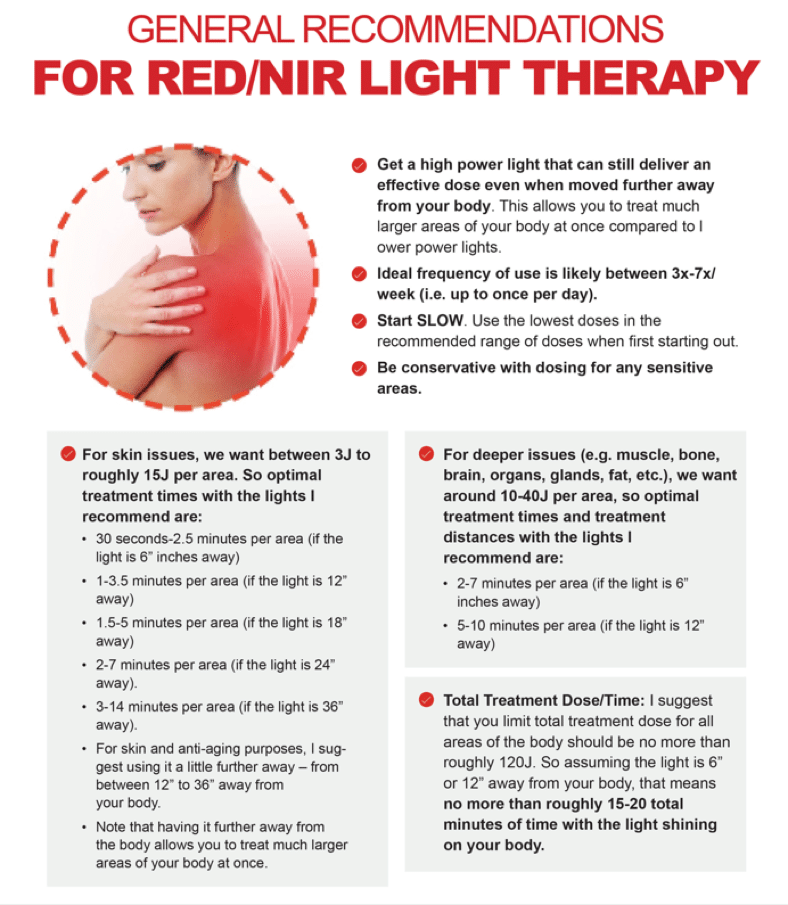
IMPORTANT: The above recommendations are based on the lights I recommend. All these calculations change when you use lights that are less powerful than the ones I recommend. If you purchase a different light, you will need to measure the power density of that light at different distances and calculate doses for that specific light according to the guidelines in this book.
Can You Overdose on Photobiomodulation? (The Biphasic Dose Response)
As I mentioned, there is something called the biphasic dose response. But what does that mean?
That means that too little red/NIR light therapy won’t provide much, if any, benefit, and too much will also negate the benefit.
In other words, it’s important to get the dose right and to be in the range I’m recommending. You aren’t doing yourself any favors by dosing higher than my guidelines suggest.
Below are two illustrations meant to give you an idea of the optimal dosing surface tissues and deep tissues. (Note: These images are not exact, because actual responses differ somewhat depending on the exact tissues treated and the type of device and other parameters used – these images are intended to illustrate the general concept of the biphasic dose response and give an idea of the general range of optimal doses.)
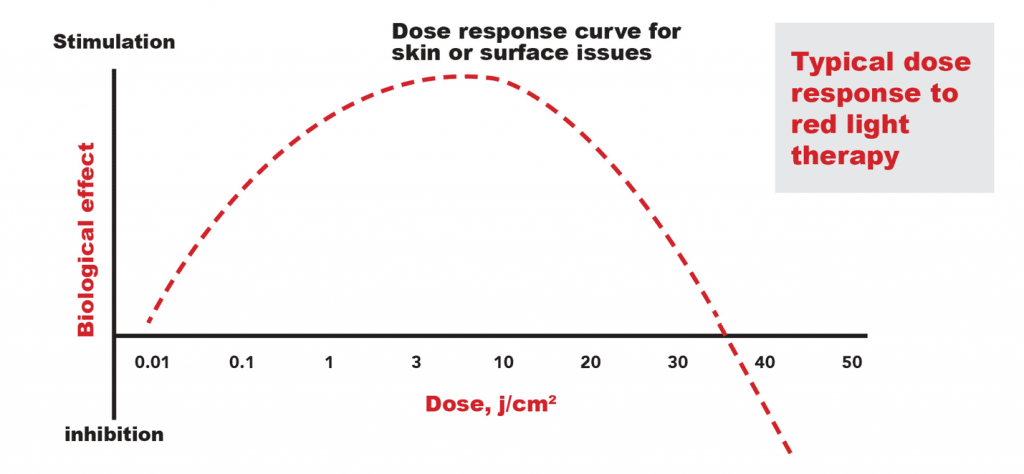
Here is an illustration of the general optimal dose range for skin and surface issues.
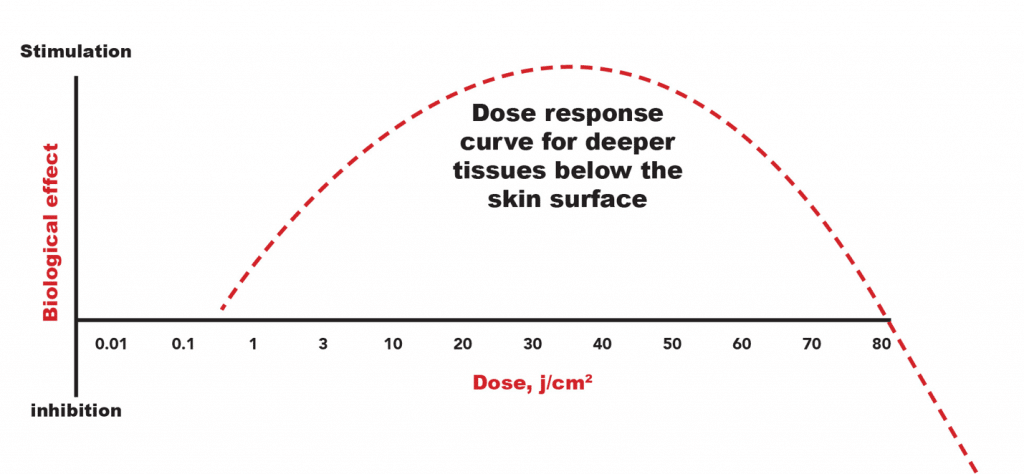
Here is an illustration of the general optimal dose range for deeper tissues beneath the skin.
I know there is a tendency in human psychology to want to do more and think that higher amounts of something will be better – i.e. “if a little is good, a lot must be better.” So let me repeat one more time for emphasis: With red/NIR light treatment, more DOES NOT equal better.
Stick with the recommended dose range, start with the lowest end of the range, and don’t be in a rush to do a lot more. The benefits may be most optimal in the lower to mid-range of the recommended dosage.
How To Get Red Light Therapy At Home (The Ultimate Guide To Red Light Therapy Devices)
When choosing the right near-infrared and red light therapy light device, you want to select a device that’s long-lasting, has a great warranty, is well-manufactured, and most importantly, one that offers the correct wavelengths at the right power density over a large area.
Here are the most important things to look for specifically include the near-infrared and red light therapy devices:
- Wavelength: What wavelengths does the device offer? Do these have health benefits? Are they in the proven ranges of 600-700nm and 780-1070nm, or better, the most researched ranges of 630-680nm and 800-880nm?
- Power Density: How much irradiance/power does the device deliver — what is the power density in mW/cm2? (To calculate this, you need to know the total wattage and the treatment area of the light.) To get optimal effects, the light needs to emit high enough power output in the therapeutic range. (Note: Most lights on the market DON’T!)
- Size of the light and treatment area: This is critically important – how big of an area will it treat? Is it a small light of less than 12” or a big light that can treat half of your body or your whole body all at once? Think about it: Do you want to hold one of these small devices by hand for 30-60 minutes to do a treatment? Probably not. You’ll get tired of using it really fast. So it has to be convenient, and ideally, has to be something that is not only fast, but something that you do while doing other things (if you wish), so you’re not sitting there holding a device in different positions for 30-60 minutes.
- Warranty: How long does the warranty last? Will you have time to find out if it works? (Hint: look for at least one year or longer.)
- What do you want it for? Depending on your specific purpose, there are a few different devices you may want to consider. (If you have specialty needs like brain health, or skin health, it will affect the wavelengths you want, the power of the device, and even the type of device.)
I cannot emphasize this enough: When choosing a red light or near-infrared light device, you want to be extremely careful to choose wisely, based on the wavelength and power density levels of the device. Most devices on the market are way underpowered and largely a waste of money.
Wavelength and intensity makes all the difference between incredible benefits and no benefits.
You Want Therapeutic Wavelengths that Achieve Real Results
Again, not all wavelengths are equal — nor all devices. Look for wavelengths in the proven therapeutic ranges.
Based on the bulk of the research, you want:
- 630-680nm (the optimal healing spectrum of red light)
- 800 to 880nm (the optimal healing spectrum of near-infrared)
- or a combination of both
Why Power Density of The Light Matters
Power density is also important because your cells need to receive a certain intensity of red light to benefit.
Remember, to know power density, you simply need to know the wattage of the light and the treatment area (as described in the guide to dosing section).
We want a sizable light that has a power density of at least 30mW/cm2, and around 100mW/cm2 from close range (e.g. 6” away). That’s what will allow us to get up to the therapeutic levels that are used in the studies – especially for the deeper tissues.
How Big is the Light and How Much of Your Body Can It Treat at Once
Most photobiomodulation devices have a very small treatment area capability.
Most handheld devices and red lights sold online as skin improving/anti-aging devices offer about 10mW/cm2 (and many of them offer far less than even that!) and only treat about a 5-10 square inch area, meaning you’d have to use the device for 30-60 minutes to cover a significant area of your body.
But if you get a device with a high power output that also treats a large area at once, that’s where the magic is.
Higher powered devices, like the lights I recommend, deliver close to 100mW/cm2 at about 6″ from the device and still have effective doses (roughly 20-30mW/cm2) even a full 24” away! This is a huge benefit, because now even a smaller light (say 15-20” long) can basically function as though it is a full human body-sized light! In other words, a powerful light that’s 15” long can be positioned 24” or even 36” away from your body, and since light spreads out the more you move away from the source, that light can now give an effective dose to nearly your entire front or back of your body at once! (Note: This way of using it is not ideal for deep tissues – it is ideal specifically for anti-aging and skin health purposes.)
So again, it can basically function the same as a light that is 3 times the physical size (i.e. a light that is the size of your entire body).
Having a high-power light that is also large enough in size allows you to treat large areas of your body at once in just a few minutes. You can treat an area like the face, the whole torso or legs, or even do multiple parts of the body and effectively, the entire body, in just a few minutes!
High-power lights are going to give you far more benefits in far less time, are more effective (especially for deep tissues), and have more flexibility in how you can use them. I strongly recommend getting a large panel light over a hand-held device. Most people who purchase the small devices end up never using them because it’s just too time consuming.
What is the Warranty and How Long Will the Device Last?
This one is very straightforward – buy from a company with a strong warranty who stand by their lights. Otherwise, you’ll likely be throwing money away and having to buy a replacement in 6 months to a year. With a high-quality red/NIR light therapy device from a reputable company, you will have it for many years without any problems whatsoever. And if there is a problem, they’ll replace it. If you’re going to spend hundreds of dollars on something, quality is key.
What is Your Goal With Using Red Light Therapy?
My general recommendation is that if you want to treat deeper tissues, prioritize near-infrared over red light. The more you want to treat skin issues, prioritize red light. That’s a general principle you can use to tailor your choice of a light to your unique needs keeping in mind that both types of light will work for most purposes.
For most purposes, a large mixed LED panel with a mix of 660nm and 850nm is the best choice.
But for specific issues, you may want to consider other options:
- For skin issues and hair loss, it is possible that red light at 660nm may be the most optimal. (Though near-infrared at 850nm will still have most of the same benefits. It’s just a question of what is most optimal.
- If you only want to treat deeper organ, gland, joint, or muscle/tendon issues (and NOT skin issues), then you may want to go with a pure 850nm light device.
- If you only want to treat your brain (e.g. for depression, anxiety, cognitive performance, or neurological disease), then near-infrared is best. (The VieLight Neuro is likely the best option for this specific purpose. See the information on this device in the “Recommended Devices” section later in this book.)
- But for most purposes and for most people, the best choice is a combination of the 660nm and 850nm LEDs in a large LED panel that will treat a large area of the body at once. This option is best because it works for basically any and all purposes you could possibly want it for. A combined near-infrared and red light therapy device offering both 660nm and 850nm will allow you to do anything you want on any given day – whether anti-aging treatments on your skin, or healing an injury or lower back pain, or muscle recovery and fat reduction.
My Recommended Lights (How To Choose The Best Red and Near-Infrared Light Therapy Device For Your Needs)
I know all this information can feel overwhelming and confusing. So let me break it down for you very simply, by giving you my top choices for devices in each category from small to large.
You want to get a light device that gives spa-worthy treatment in your own home. While treatments from health professionals and doctors using red/NIR light therapy can cost hundreds of dollars, a wise one-time investment in a high-quality light will allow you to do treatments at home that would cost tens of thousands of dollars if you were to go to an anti-aging clinic or doctor’s office for treatment.
By the way, I happen to know of some anti-aging clinics that use the exact lights I’m recommending, but charge people $75-$150 for a single session with the light. Now you know how to accomplish this in the privacy of your own home, at your own convenience, while – after the initial purchase of the light – only costing cents to use each day.
Best Small Red Light Therapy Device
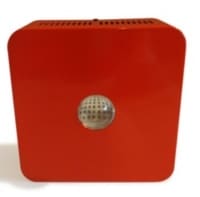
I do not recommend the small devices, as they are extremely underpowered and only irradiate a small portion of your body. So in general, I think it is much wiser to spend a little more and get a much bigger and higher power device.
But if you must get a small device (or you only want to treat a very small part of your body), the only small light that I recommend is this one from Red Light Man.
It’s a 100 watt light with LEDs split between 610nm, 630nm, 660nm, and 680nm. Or you can get it as solely a 670nm light. I recommend doing the latter, because 670nm will active cytochrome c oxidase in the mitochondria more effectively than lower wavelengths like 610nm. This light will have a good power density at about 4-5” away from the light, but remember, it’s a small light, so light will only hit a small part of your body. (Note: The effective power density of therapeutic light is considerably lowered by the fact that some of the wavelengths – especially 610nm – used in this light are outside the optimal therapeutic wavelengths, so be aware of that if you get this device with the mixed wavelengths.)
To treat larger areas of your body at once – which I strongly recommend doing for time-efficiency and to get greater benefits, especially for general skin anti-aging uses – you’ll definitely want to get a larger light.
In general, it’s best to spend your money (even if you have to save up) on a larger more powerful light rather than rushing to get a small one.
Best Medium Sized Near-Infrared and Red Light Devices
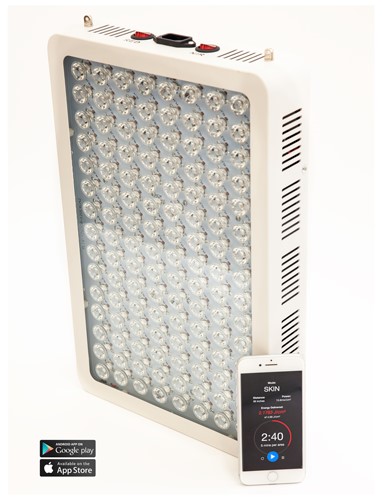
These lights get into the optimal range for power output and size, so they can treat a large portion of your body at once with a sufficient dose.
These devices generally cost upwards of $450 and deliver upwards of 120-300 watts of power to large portion of your body (like large muscle groups and a large portion of the torso at once). This is a huge time-saver when compared with treating the same areas with a small device and will lead to better results. Also, since some of the effects of the light are from irradiating the blood and lowering inflammation, the larger lights will treat more of the blood at once and will have better body-wide effects.
My top choices in medium size devices are as follows:
- Red Rush360 by RedTherapy.co.
- It’s 360 watts.
- It’s 16.3” tall by about 10.6” wide.
- It has 120 LEDs.
- It comes with a 50-50 split of 660nm and 850nm.
- The price is excellent at $449
- The Joovv Mini
-
- It has 60 LED and is listed as 120 watts.
- It’s available in 660nm, all in 850nm, or a 50-50 split of 660nm and 850nm.
- Has FDA clearance (which means that it meets standards for safety and quality of the parts and the manufacturing process).
- The price is $695
-
- The BIO-300 by Platinum Therapy Lights
- It’s listed at 300 watts.
- It’s 19” tall by about 9” wide.
- It has 100 LEDs.
- It’s available in 660nm, all in 850nm, or a 50-50 split of 660nm and 850nm.
- It’s $449
These are all great options.
Now, if you want a large light to treat the whole front or whole back of your body at once with high power density, I would strongly recommend considering the larger and more powerful half-body units.
Best Large Near-Infrared and Red Light Therapy Devices

These units generally cost upwards of $700 to $2,500, with a couple great options of large, high power effective lights for under $1,000.
There are much more expensive options available and full body devices like tanning beds that can treat basically every inch of your body at once, but these are far more expensive and unnecessary for most people. There are a lot more expensive “luxury” red light options for those that want them, but in my opinion, there is really no need to go beyond the lights in this category.This is the category that provides all you need to get great results at a very reasonable price. In my opinion, these half body devices are a fraction of the price, and essentially offer the same benefits.
Several of the devices in this category are much higher power (relative to the medium-sized lights), from about 300 watts on the low end to 600 watts.
This is a great thing, especially when combined with being able to shine light on a much larger area of your body at once, because this will dramatically increase the overall number of photons hitting your body and the dose you receive. Thus, the effects are stronger, and the benefits are greater – especially if you want to treat deeper tissues in larger areas of your body, for organ health, muscle gain, and fat loss, etc. And you can do less treatment time per session.
Plus, if you want to treat deep tissues in large areas of your body at once, it’s very time-efficient with sessions of just a few minutes, whereas with smaller devices, it can be more time consuming by having to treat multiple areas.
So if you’re looking for a large high power device to do full body treatments, this is ideal.
Here are the large high power devices I recommend:
- Red Rush720 by RedTherapy.co.
- It’s 360 watts.
- It’s 35” tall by about 10.6” wide.
- It has 240 LEDs.
- It comes with a 50-50 split of 660nm and 850nm.
- The price is excellent at $779.00
- Joovv Solo:
- It’s 12″ x 40″.
- It comes with either in 660nm, all in 850nm, or a 50-50 split of 660nm and 850nm.
- Has FDA clearance (a status that ensures they use safe and quality parts in their device)
- The price is $1,195
- The BIO-600 by Platinum Therapy Lights:
- It’s 36” tall by about 8” wide.
- You can also get this in either in 660nm, all in 850nm, or a 50-50 split of 660nm and 850nm.
- The price is $789
- The Full Stack by Red Light Rising:
- It’s a great option for people in the UK and Europe to get a high quality light at a good price with low shipping costs
- It’s $772 (Use the discount code “energy blueprint” for $40 off)
Full Body Near-Infrared and Red Light Therapy Device
There is also the option of doing a light setup that will shine on the full front or back of your body from head to toe.
- Joovv has a selection of high quality LEDs in very large sizes that cover the whole length of the body — the DUO and QUAD. Prices range from $2,195-$3,995. They come with the same options of either pure 660nm, pure 850nm, or a 50-50 mix of the two.
Ultra High End Near-Infrared and Red Light Therapy Options
Joovv has an extremely large, high quality LED panel. It looks like it is big enough to even treat two people at once. It’s priced at $5,995.
There are also a couple options for super high-end tanning bed-style red light therapy units. These are generally priced in excess of $15,000 with one well-known brand selling their unit for upwards of $100,000!
I put these full body tanning bed style devices here in case you’re interested in very high-end devices (and you’re doing well enough financially to entertain such purchases), but to be honest, I really do not think such devices are necessary. I do not believe that the benefits of these devices will be vastly superior to the other far cheaper lights I recommend.
Here are the two tanning-bed style whole body options:
- Mitogen Red Light Bed. This consists of 10,000 LEDs that are a mix of 660nm and 850nm light (the same wavelengths as the RedRush and Platinum light. The power density is 15mW/cm2. Treatment times will generally be about 10-25 minutes.
- NovoThor (a well-known manufacturer of laser devices) also offers a full-body tanning bed-style LED device. This one is a mix of 630nm, 660nm, and 850nm. It has a power density of 17mW/cm2. And it costs over $100k. This is most likely an option either for extremely wealthy people or a professional gym/spa/medical setting
To be clear, I am in NO WAY implying or suggesting that you need to purchase these ultra-expensive tanning bed style devices.
I mention these purely for the sake of presenting all the options on the market, but again, this is not to be interpreted as me implying that you should purchase these luxury red/NIR devices. I believe that you can get all the benefits of red/NIR light therapy with the far less expensive LED panels recommended above.
Sauna + Red/NIR Light Therapy Options
There are a few sauna brands make far-infrared saunas that also add near-infrared light into their sauna. This allows you to get all the benefits of near-infrared light discussed in this book while also getting the benefits of the sauna heat (sweating, detoxification, mitochondrial benefits, etc.).
These are a great option, provided you have the money for it, as they are considerably more expensive than the pure red/NIR devices.
If you want something in this category, Sunlighten saunas, ClearLight saunas, Sun Stream Saunas all make ultra high quality wooden full-spectrum saunas. With this type of premium sauna, you can get far-infrared + near-infrared saunas and enjoy all the benefits of both near-infrared therapy and a traditional far-infrared sauna.
SaunaSpace manufactures heat lamp saunas that use 4 incandescent heat lamp bulbs. These will have both far-infrared and near-infrared and red light. They come with a canvas tent (as opposed to a wooden room), and thus are considerably less expensive than the wooden saunas made by the brands listed above. You can get their “Pocket Sauna” here.
For those who can afford it, these are excellent options. It’s also convenient as it allows you to get your near-infrared treatment while doing a sauna session. I highly recommend the Sunlighten mPulse line and the SaunaSpace saunas.
Top Light for Use on the Brain
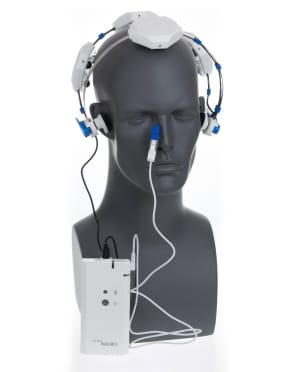
If you’re using light on the brain specifically – for either a brain health issue or to improve mood or cognitive function – it’s important to get a light with near-infrared, not just red light. Research has shown that near-infrared is more effective in penetrating the skull than red light (which has minimal to no penetration of the skull), so this is ideal for the brain.
The LED panel lights I recommend like the Red Rush360 and Platinum Lights have near-infrared (either pure near-infrared or mixed near-infrared with red), and are powerful enough to be used on the forehead and will likely be effective in penetrating the skull with some light.
Nevertheless, if your main goal is to treat the brain, the best option is the VieLight Neuro, which has multiple contact points on the head (that can be worked into contact the scalp to allow light to penetrate through the hair) and will likely have the best results for brain-specific issues. (Note: This device is designed specifically to be worn on the head and thus, won’t work well at all to treat other areas of the body.)
Please note that they also sell intranasal devices that claim to target the brain, but Michael Hamblin, PhD does not believe these devices actually do reach the brain directly[329], therefore, I do not advocate those devices. Yet they do have some positive research. Hamblin believes that they don’t work by directly irradiating the brain, but that they work through irradiating the blood through the capillaries, which indirectly affects the brain (and other systems of the body). Assuming he is correct, it really does not make sense to use these low-power intranasal devices to treat the blood – it would be much better to use a high power (and much larger) LED device for that purpose.
Having said that, the VieLight Neuro has the head unit which likely does effectively target the brain. And the VieLight Neuro may very well be the best product for treating the brain specifically. We don’t know for sure, as there are no studies comparing it directly to LED lights, but there is research supporting the use of this product in treating dementia.[330]
Other options:
- Photopuncture Kit from The Photonic Therapy Institute.
- REDjuvenator – (Note: Much lower light output than the devices recommended below.)
- GembaRed – (A small, relatively low-power 45W panel. Much lower light output than the devices recommended below.)
Animal treatment devices:
- Photopuncture Kit.
- RevitaVet Wraps. LED wraps to lay on your animal.
- Equine Light Therapy. LED wraps to lay on your animal, and many light therapy accessories for dogs and horses.
My Top Overall Best All-Purpose Red Light Devices
Taking into account all of the previously mentioned factors, here are my personal recommendations for the lights that are the most powerful, cost-effective, and provide amazing bang for the buck (presented in no particular order). All of these devices get my highest recommendations.
You can get this light HERE.
Discount Code: They will give a $25 discount to readers of this book bringing total cost down to $749. Just enter the discount code “energy blueprint” when checking out.
Discount Code: They will give a $25 discount to readers of this book bringing total cost down to $424. Just enter the discount code “energy blueprint” when checking out.
You can get these lights HERE.
You can get this light HERE.
Discount Code: They will give a $25 discount to readers of this book bringing total cost down to $424. Just enter the discount code “energy blueprint” when checking out.
You can get this light device HERE.
Discount Code: They will give a $40 discount to readers of this book bringing total cost down to $749. Just enter the discount code “energy blueprint” when checking out.
- The Full Stack by Red Light Rising ($722)
(Use the discount code “energy blueprint” for $40 off)
(DISCLOSURE: As you can see, I have arranged discounts for you with some of these manufacturers offering high-quality devices. I was not able to arrange discounts with all of the manufacturers listed here, but I tried to do it with every manufacturer that was open to offering a discount to readers of this guide. Please be aware that I do get a small commission on any of these devices that you purchase if you use my discount code. If you appreciate the work I’ve done in writing this guide, I appreciate you using my discount code. That is how I get rewarded for this work. Please know that this is at no expense to you. In fact, I have negotiated directly with these manufacturers to get you discounts off the normal prices by letting them know that you were referred by this book. In short, everyone wins. But if you have any objection to this, feel free to order the lights without using the discount code. Please know that my rankings of these devices are in no way influenced by this. I have no ownership in any of these companies or vested financial interest in promoting any one of them over another. My recommendations for which light devices you should get are exactly the same whether you choose to use the discount codes or not. Moreover, there are in fact many other devices I could promote that offer much more generous commissions, which I am actually not promoting because they do not offer high quality devices. I give you my word that all my rankings here are best on a purely objective analysis of the power output, quality, and bang-for-the-buck of all these devices. My #1 priority is making sure that you get the best device for your needs. I have done my best to negotiate the biggest discounts for you as possible with all of the manufacturers who were open to giving discounts.)
Best Brain Device
VieLight Neuro Alpha or Neuro Gamma – $1,749 You can purchase through their website here.
Discount code is “energy blueprint” which gets you 10% off, which equates to $175 off the regular price. Note: I recommend the Neuro Alpha over the Gamma.
The clear winners for general LED panels that can be used for basically any purpose are the Red Rush360, Joovv Solo and DUO, and Platinum Therapy Lights LED panels, which powerful lights and offer amazing bang-for-the-buck.
With these setups, you can get all the benefits of red and near-infrared light therapy (that a clinic might charge over $100 per session for!) in the comfort of your own home with unlimited sessions for less than $1,000 or even less than $500.
Wrapping Up
If all of the complexity and science talk has you feeling overwhelmed, I want to end with some simplicity. I’ve tried to cover the nuances of the science on this topic in this book, but I don’t want you to get so caught up in all the details that you feel overwhelmed and confused on how to get started and actually do a red/NIR light therapy session. So let me summarize the practical aspects of all this in a very simple way:
- Go get yourself one of the recommended light devices (e.g. RedRush360 or Joovv Solo or Duo).
- Switch the light on.
- Put your chosen body area in front of it for a few minutes (following the dosing guidelines for different body areas and treatment goals).
That’s it. It’s really that simple.
Once you are comfortable with those basic three steps, then go through the details of my recommended dosing guidelines to make sure you’re doing optimal treatments for the specific body area (e.g. skin issues vs. deep tissues). Then make sure to go through the specific strategies, tips, and protocols I offer in the section titled “Practical Tips and Strategies for Specific Goals” to get more specific detailed guidance on using the light for specific goals you may have like brain enhancement, muscle/strength gain, overcoming fatigue, improving mood, fat loss, sleep, or anti-aging.
It’s that simple.
After you get one of these lights, you can immediately start using it to:
- Increase your energy
- Make your skin healthier and get rid of cellulite
- Speed up fat loss
- Improve muscle recovery and athletic performance
- Improve mood and cognitive function
- Increase muscle size and strength
- Speed healing from injury
- Improve metabolic and hormonal health
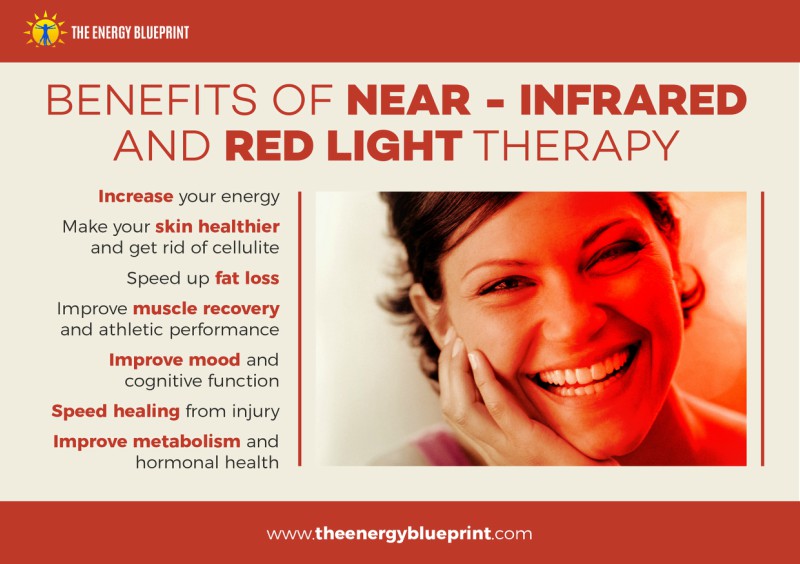
You now know everything you need to know to start using this powerful technology. Now go start using it and taking your health, body and energy to new heights!
Summary
In summary, near-infrared and red light therapy are incredibly powerful tools you can use to dramatically enhance your health. As I said at the beginning of this book, if there were a drug that had scientific research showing all these benefits, it would be an absolute blockbuster drug for pharmaceutical companies – it would be hailed as a “miracle drug” and prescribed to basically everyone.
Here’s the best part: That “drug” exists. It’s just not in the form of a pill. It’s in the form of near-infrared and red light therapy!
References
[1] Freitas de Freitas et al. (2016) Proposed Mechanisms of Photobiomodulation or Low Level Light Therapy
[2] Hamblin, M, et al. (2018). Low-level light therapy: Photobiomodulation. Society of Photo-Optical Instrumentation Engineers (SPIE).
[3] Câmara AB, et al. (2018). Sunlight Incidence, Vitamin D Deficiency, and Alzheimer’s Disease. J Med Food. 2018 Mar 22. doi: 10.1089/jmf.2017.0130.
[4] Sorenson, M, (2016). New Research Sheds More Light on Parkinson’s Disease Sunlight Institute
[5] Wang, J, et al. (2016). Vitamin D and Sunlight Exposure in Newly-Diagnosed Parkinson’s Disease Nutrients. 2016 Mar; 8(3): 142.
[6] Tremlett, H, et al. (2018) Sun exposure over the life course and associations with multiple sclerosis American Academy of Neurology
[7] Egan, K. M, et al. (2005). Sunlight and Reduced Risk of Cancer: Is The Real Story Vitamin D? JNCI: Journal of the National Cancer Institute, Volume 97, Issue 3, 2 February 2005, Pages 161–163
[8] Holick MF, (2013). Vitamin D, sunlight, and cancer connection. Anticancer Agents Med Chem. 2013 Jan;13(1):70-82.
[9] Holick, MF, (2014) Cancer, sunlight, and Vitamin D. Journal of Clinical & Translational Endocrinology Volume 1, Issue 4, December 2014, Pages 179-186
[10] van der Rhee, H.J, et al. (2006). Does sunlight prevent cancer? A systematic review EJC September 2006 Volume 42, Issue 14, Pages 2222–2232
[11] Fleury, N, et al. (2016). Sun Exposure and Its Effects on Human Health: Mechanisms through Which Sun Exposure Could Reduce the Risk of Developing Obesity and Cardiometabolic Dysfunction Int J Environ Res Public Health. 2016 Oct; 13(10): 999.
[12] Gorman, S, et al. (2017). Ultraviolet radiation, vitamin D and the development of obesity, metabolic syndrome and type-2 diabetes. Photochem Photobiol Sci. 2017 Mar 16;16(3):362-373. doi: 10.1039/c6pp00274a.
[13] Fleury, N, et al. (2016). Sun Exposure and Its Effects on Human Health: Mechanisms through Which Sun Exposure Could Reduce the Risk of Developing Obesity and Cardiometabolic Dysfunction Int J Environ Res Public Health. 2016 Oct; 13(10): 999.
[14] Gorman, S, et al. (2017). Ultraviolet radiation, vitamin D and the development of obesity, metabolic syndrome and type-2 diabetes. Photochem Photobiol Sci. 2017 Mar 16;16(3):362-373. doi: 10.1039/c6pp00274a.
[15] Fleury, N, et al. (2016). Sun Exposure and Its Effects on Human Health: Mechanisms through Which Sun Exposure Could Reduce the Risk of Developing Obesity and Cardiometabolic Dysfunction Int J Environ Res Public Health. 2016 Oct; 13(10): 999.
[16] Frellick, M, (2016) Avoiding Sun as Dangerous as Smoking, Medscape
[17] Lindqvist, PG, et al. (2014). Avoidance of sun exposure is a risk factor for all-cause mortality: results from the Melanoma in Southern Sweden cohort. J Intern Med. 2014 Jul;276(1):77-86. doi: 10.1111/joim.12251. Epub 2014 Apr 23
[18] Keshet-Sitton, A, et al. (2017). Illuminating a Risk for Breast Cancer: A Preliminary Ecological Study on the Association Between Streetlight and Breast Cancer Integr Cancer Ther. 2017 Dec; 16(4): 451–463.
[19] Al-Naggar, RA, et al. (2016). Artificial Light At Night and Cancer: Global Study Asian Pac J Cancer Prev. 2016; 17(10): 4661–4664. doi: 10.22034/APJCP.2016.17.10.4661
[20] De Nike, L, et al. (2012). Study links exposure to light at night to depression, learning issues
[21] Rybnikova, NA, et al. (2016). Does artificial light-at-night exposure contribute to the worldwide obesity pandemic? International Journal of Obesity volume 40, pages 815–823 (2016) doi:10.1038/ijo.2015.255
[22] McFadden, E, et al. (2014). The Relationship Between Obesity and Exposure to Light at Night: Cross-Sectional Analyses of Over 100,000 Women in the Breakthrough Generations Study American Journal of Epidemiology, Volume 180, Issue 3, 1 August 2014, Pages 245–250,
[23] Fonken, LK, et al. (2014) The Effects of Light at Night on Circadian Clocks and Metabolism Endocrine Reviews, Volume 35, Issue 4, 1 August 2014, Pages 648–670
[24] Science Daily, (2017). Artificial light from digital devices lessens sleep quality Endocrine Reviews, Volume 35, Issue 4, 1 August 2014, Pages 648–670
[25] De Nike, L, et al. (2012). Study links exposure to light at night to depression, learning issues
[26] Huang, Y-Y, et al. (2009) Biphasic Dose Response in Low Level Light Therapy Dose Response. 2009; 7(4): 358–383.
[27] Hamblin, M. (2008). The role of nitric oxide in low level light therapy. Proceedings of SPIE – The International Society for Optical Engineering 6846 · February 2008 with 2,541 Reads DOI: 10.1117/12.764918
[28] Hamblin, M, et al. (2018). Low-level light therapy: Photobiomodulation. Society of Photo-Optical Instrumentation Engineers (SPIE).
[29] Hamblin, M. (2008). The role of nitric oxide in low level light therapy. Proceedings of SPIE – The International Society for Optical Engineering 6846 · February 2008 with 2,541 Reads DOI: 10.1117/12.764918
[30]Farivar, S. et al. (2014). Biological Effects of Low Level Laser Therapy. Journal of Lasers in Medical Science.
[31] Sommer A.P. et al. (2015) Light Effect on Water Viscosity: Implication for ATP Biosynthesis
[32] Sommer A.P. et al. (2015) Light Effect on Water Viscosity: Implication for ATP Biosynthesis
[33] Sommer A.P. et al. (2015) Light Effect on Water Viscosity: Implication for ATP Biosynthesis
[34] Qu, J. (2013). Dietary chlorophyll metabolites catalyze the photoreduction of plasma ubiquinone. Photochemistry and Photobiology.
[35]Sommer A.P. et al. (2015) Light Effect on Water Viscosity: Implication for ATP Biosynthesis
[36] Oron et al. (2010). Lasers stimulate stem cells and reduce heart scarring after heart attack, study suggests.
[37] Hofling, D. (2013) Low- level laser in the treatment of patients with hypothyroidism induced by chronic autoimmune thyroiditis: a randomized, placebo-controlled clinical trial. Lasers in Medicine and Science, 28(3):743-53.
[38] Luo et al. (2013). Effects of low-level laser therapy on ROS homeostasis and expression of IGF-1 and TGF-β1 in skeletal muscle during the repair process.
[39] Lau et al. The effects of low level laser therapy on irradiated cells: a systematic review
[40]Myakishev-Rempel, M. (2015). Red Light Modulates Ultraviolet-Induced Gene Expression in the Epidermis of Hairless Mice.
[41] Cohen, J. 8 Amazing Health Benefits of Red Light Therapy – with Mechanisms
[42][42]Guo, J. (2015). Visible red and infrared light alters gene expression in human marrow stromal fibroblast cells. Orthodonics and Craniofascial Research, 18(01): 50–61.
[43] Pugliese, L. Et al. (2003). The influence of low-level laser therapy on biomodulation of collagen and elastic fibers Pesqui. Odontol. Bras. vol.17 no.4 São Paulo Oct./Dec. 2003
[44] Lau et al. The effects of low level laser therapy on irradiated cells: a systematic review
[45] Avci P, et al. (2013) Low-level laser (light) therapy (LLLT) in skin: stimulating, healing, restoring. Semin Cutan Med Surg. 2013 Mar;32(1):41-52.
[46] Lau et al. The effects of low level laser therapy on irradiated cells: a systematic review
[47]Jiang, M. et. al. (2017). A prospective study of the safety and efficacy of a combined bipolar radiofrequency, intense pulsed light, and infrared diode laser treatment for global facial photoaging. Lasers in Medicine and Science, 32(5):1051-1061.
[48]Kim, Hee-Kyong. (2017). Effects of radiofrequency, electroacupuncture, and low-level laser therapy on the wrinkles and moisture content of the forehead, eyes, and cheek. Journal I Physical Therapy and Science, 29(2): 290–294.
[49]Pinar, Avci. Low-level laser (light) therapy (red and near-infrared light) in skin: stimulating, healing, restoring. SCMS, 32(1): 41-52.
[50]Barolet, D. (2009). Ba Regulation of Skin Collagen Metabolism In VitroUsing a Pulsed 660 nm LED Light Source: Clinical Correlation with a Single-Blinded Study, Journal of Investigative Dermatology, 129(12): 2751-2759.
[51]Wunsch, A. (2014). A Controlled Trial to Determine the Efficacy of Red and near-infrared light Treatment in Patient Satisfaction, Reduction of Fine Lines, Wrinkles, Skin Roughness, and Intradermal Collagen Density Increase. Photomedicine in Lasers and Surgery, 32(2): 93–100.
[52] Fabiana do Socorro da Silva Dias Andrade et al. (2014) Effects of low-level laser therapy on wound healing
[53]Jiang, M. et. al. (2017). A prospective study of the safety and efficacy of a combined bipolar radiofrequency, intense pulsed light, and infrared diode laser treatment for global facial photoaging. Lasers in Medicine and Science, 32(5):1051-1061.
[54] Barolet, D. et. al. (2016). Accelerating Ablative Fractional Resurfacing Wound Healing Recovery by Photobiomodulation, Current Dermatology Reports, 5(3): 232-38.
[55]Lanzafame, R. J. et. al. (2014). The growth of human scalp hair in females using visible red light laser and LED sources. Lasers in Surgery and Medicine, 46(8): 601-607.
[56] Wiley, A. et. al. Hair stimulation following laser and intense pulsed light photo-epilation: Review of 543 cases and ways to manage it. Lasers in Surgery and Medicine, 39(4): 297-301.
[57] Kim, S.S. et. al. (2007).Phototherapy of androgenetic alopecia with low level narrow band 655-nm red light and 780-nm infrared light. J of American Academy of Dermatology. American Academy of Dermatology 65th Annual Meeting. p. AB112.
[58] Jimenez JJ., et al. (2014) Efficacy and safety of a low-level laser device in the treatment of male and female pattern hair loss: a multicenter, randomized, sham device-controlled, double-blind study.
[59] Dodd EM., et al. (2017) Photobiomodulation therapy for androgenetic alopecia: A clinician’s guide to home-use devices cleared by the Federal Drug Administration. J Cosmet Laser Ther. 2018 Jun;20(3):159-167. doi: 10.1080/14764172.2017.1383613. Epub 2017 Dec 5.
[60] Adil A., et al. (2017) The effectiveness of treatments for androgenetic alopecia: A systematic review and meta-analysis, J Am Acad Dermatol. 2017 Jul;77(1):136-141.e5. doi: 10.1016/j.jaad.2017.02.054. Epub 2017 Apr 7.
[61] Gold et al. (2011). Reduction in thigh circumference and improvement in the appearance of cellulite with dual-wavelength, low-level laser energy and massage.
[62] Avci et al. (2013). Low-level laser (light) therapy (LLLT) in skin: stimulating, healing, restoring.
[63]Vranova et. al. (2015). Comparison of quality of facial scars after single low-level laser therapy and combined low-level with high-level (PDL 595 nm) laser therapy. Dermatologic Therapy.
[64] Balboni, G.C., et. al. (1986) Effects of He-Ne/I.R. lasers irradiation on two lines of normal human fibroblasts in vitro. Arch Italian journal of Anatomy and Embryology, 91:179–188.
[65] Bosarta, M., et. al. (1984) In vitro fibroblast and dermis fibroblast activation by laser irra- diation at low energy. Dermatologica, 168:157–162
[66]Lam, T.S., et. al. (1986) Laser stimulation of collagen synthesis in human skin fibroblast cultures. Lasers in the Life Sciences, 1:61–77
[67]Trelles, M. A. et. al. (2006). Red light-emitting diode (LED) therapy accelerates wound healing post-blepharoplasty and periocular laser ablative resurfacing. Journal of Cosmetic Laser Therapy, 8(1): 39-42
[68]Barolet, D. et. al. (2016). Accelerating Ablative Fractional Resurfacing Wound Healing Recovery by Photobiomodulation, Current Dermatology Reports, 5(3): 232-38.
[69]de Abreu Chaves, M. E. et. al. (2014). Effects of low-power light therapy on wound healing: LASER x LED*. Anais Brasileiros de Dermatologia. 89(4): 616–623.
[70]de Lima, F. (2014). Use alone or in Combination of Red and Infrared Laser in Skin Wounds. Lasers in Medicine and Science, (2): 51–57.
[71]Mester, E. et. al. (1978). Stimulation 532 of wound healing by means of laser rays. Acta Chir Acad Sci Hung 19:163–170
[72] Mester, E, et. al. (1985). The biomedical effects of laser application. Lasers in Surgery and Medicine, 5:31–39.
[73] Kana, J. S., et. al. (1981). Effect of low-power density laser radiation on healing of open skin wound in rats. Archives in Surgery, 116:293–296.
[74]Ruaro, J. A. (2014). Low-level laser therapy to treat fibromyalgia. Lasers and Medicine in Science, 29(6):1815-9.
[75] Onur, A. (2006). Long-term efficacy of low level laser therapy in women with fibromyalgia: A placebo-controlled study. Journal of Back and Musculoskeletal Rehabilitation, 19(4): 135-40.
[76] Gur, A. (2002). Efficacy of low power laser therapy in fibromyalgia: a single-blind, placebo-controlled trial. Lasers in Medical Science, 17(1): 57-61.
[77] Ruaro, J. A. (2014). Low-level laser therapy to treat fibromyalgia. Lasers and Medicine in Science, 29(6):1815-9.
[78] Da Silva, M. et al. (2017). Randomized, blinded, controlled trial on effectiveness of photobiomodulation therapy and exercise training in the fibromyalgia treatment. Lasers in Medical Science.
[79] Komaroff, A. (2017). Inflammation correlates with symptoms in chronic fatigue syndrome. PNAS.
[80] Johnson, Cort. (2017). Major Stanford Study Indicates Chronic Fatigue Syndrome (ME/CFS) is Inflammatory Disorder.
[81] Cohut, M. (2017). Is chronic fatigue syndrome an inflammatory disease? Medical News Today.
[82] Cordero, MD. et al. (2010). Oxidative stress and mitochondrial dysfunction in fibromyalgia. Neuro Endocrinology Letters.
[83] Myhill, S. et al. (2009). Chronic fatigue syndrome and mitochondrial dysfunction. International Journal of Clinical and Experimental Medicine.
[84] Natelson, B. (2013). Brain dysfunction as one cause of CFS symptoms including difficulty with attention and concentration. Frontiers in Physiology.
[85] Hofling, D. (2013) Low- level laser in the treatment of patients with hypothyroidism induced by chronic autoimmune thyroiditis: a randomized, placebo-controlled clinical trial. Lasers in Medicine and Science, 28(3):743-53.
[86] HOFLING, D., et al. (2017) long-term follow-up of patients with hypothyroidism induced by autoimmune thyroiditis submitted to low-level laser therapy
[87] Heiskanen V. “Valtsu” (205). Hypothyroidism: Could it be treated with light? Valtsu’s.
[88] Heiskanen V. “Valtsu” (205). Hypothyroidism: Could it be treated with light? Valtsu’s.
[89] Heiskanen V. “Valtsu” (205). Hypothyroidism: Could it be treated with light? Valtsu’s.
[90] Heiskanen V. “Valtsu” (205). Hypothyroidism: Could it be treated with light? Valtsu’s.
[91] Heiskanen V. “Valtsu” (205). Hypothyroidism: Could it be treated with light? Valtsu’s.
[92] Wu, S., t. al. (2014). Cancer phototherapy via selective photoinactivation of respiratory chain oxidase to trigger a fatal superoxide anion burst. Antioxidants and Redox Signal, 20(5):733–746.
[93] Cohen, J. (2017) Interview With Dr Michael Hamblin: Harvard Professor and Infrared Therapy Expert
[94] Santana-Blank, L.A., (2004). Microdensitometry of T2-weighted magnetic resonance (MR) images from patients with advanced neoplasias in a phase I clinical trial of an infrared pulsed laser device (IPLD). Lasers in Surgery and Medicine, 34:398–406
[95] Santana-Blank, L., (2012). Concurrence of emerging developments in photobiomodulation and cancer. Photomedicine and Laser Surgery 30:615–616 .
[96] Santana-Blank, L., et. al. (2014). Water–light interaction: a novel pathway for multi hallmark therapy in cancer. International Journal of Cancer Therapy and Oncology, 2:02012
[97] Coussens, L.M., t. al. (2013). Neutralizing tumor-promoting chronic inflammation: a magic bullet? Science, 339:286–291.
[98] Tanaka, Y., et. al. (2010). Non-thermal cytocidal effect of infrared irradiation on cultured cancer cells using specialized device. Cancer Science, 101:1396–1402.
[99] Traitcheva, N., (2003). ELF fields and photooxidation yielding lethal effects on cancer cells. Bioelectromagnetics, 24:148–150.
[100] Radeva, M., (2004). Differences in lethality between cáncer cells and human lymphocytes caused by LF-electromagnetic fields. Bioelectromagnetics, 25:503–507.
[101] Wang F., et. al. (2005). Measuring dynamics of caspase-3 activity in living cells using FRET technique during apoptosis induced by high fluence low power laser irradiation. Lasers in Surgery and Medicine36:2–7.
[102] Tanaka, Y., et. al. (2010). Non-thermal cytocidal effect of infrared irradiation on cultured cancer cells using specialized device. Cancer Science, 101:1396–1402
[103] Kazem Shakouri S et al. (2010) Effect of low-level laser therapy on the fracture healing process.
[104] Hamblin, M, et al. (2018). Low-level light therapy: Photobiomodulation. Society of Photo-Optical Instrumentation Engineers (SPIE).
[105] Hamblin, M, et al. (2018). Low-level light therapy: Photobiomodulation. Society of Photo-Optical Instrumentation Engineers (SPIE).
[106] Hamblin, M, et al. (2018). Low-level light therapy: Photobiomodulation. Society of Photo-Optical Instrumentation Engineers (SPIE).
[107] Hamblin, M, et al. (2018). Low-level light therapy: Photobiomodulation. Society of Photo-Optical Instrumentation Engineers (SPIE).
[108]Zein, R. (2017). Effect of Low-Level Laser Therapy on Bone Regeneration During Osseointegration and Bone Graft. Photomedicine and Laser Surgery, [Epub ahead of print]
[109] Mostafavinia, A. (2017). Effect of in vivo low-level laser therapy on bone marrow-derived mesenchymal stem cells in ovariectomy-induced osteoporosis of rats. Journal of Photochemistry and Photobiology,175:29-36.
[110]Pinheiro, A. L. B. (2006). Photomedicine and Laser Surgery. Photoengineering of Bone Repair Processes, 24(2): 169-178
[111] Franceschi C (2014). Chronic inflammation (inflammaging) and its potential contribution to age-associated diseases.
[112]Lyons, J-A. (2015). Light therapy to treat autoimmune disease SPIE Newsroom.
[113]Brosseau, L. Low level laser therapy (Classes I, II and III) for treating rheumatoid arthritis. Cochrane Musculoskeletal Group.
[114]Alfaya, T. A. et. al. (2012). Sjogren’s syndrome: Use of a low-level laser for treatment of xerostomia, Medical Science Technology, 53(4): CR197-200
[115] Cotler at al. (2015). The Use of Low Level Laser Therapy (LLLT) For Musculoskeletal Pain.
[116]Albarracin, R. et. al. Photobiomodulation protects the retina from light-induced photoreceptor degeneration. Investigative Ophthalmological and Visual Science, 52(6):3582-92.
[117]Ivandic, B. T. et. al. (2008). Low-level laser therapy improves vision in patients with age-related macular degeneration. Photomedicine and Laser Surgery, 26(3):241-5.
[118]Cassano, P. (2016). Review of transcranial photobiomodulation for major depressive disorder: targeting brain metabolism, inflammation, oxidative stress, and neurogenesis. Neurophotonics, 3(3):031404.
[119] Fahim, C, et al. (2004) Abnormal prefrontal and anterior cingulate activation in major depressive disorder during episodic memory encoding of sad stimuli Brain Cogn. 2004 Mar;54(2):161-3.
[120] Schaffer, M, et al. (2000) Effects of 780 nm diode laser irradiation on blood microcirculation: preliminary findings on time-dependent T1-weighted contrast-enhanced magnetic resonance imaging (MRI). J Photochem Photobiol B. 2000 Jan;54(1):55-60.
[121] Henderson et al. (2015). Near-infrared photonic energy penetration: can infrared phototherapy effectively reach the human brain? Neuropsychiatric Disease and Treatment.
[122] Schiffer, F, et al. (2009). Psychological benefits 2 and 4 weeks after a single treatment with near infrared light to the forehead: a pilot study of 10 patients with major depression and anxiety.
[123]Disner, S. G. (2016). Transcranial Laser Stimulation as Neuroenhancement for Attention Bias Modification in Adults with Elevated Depression Symptoms. Sep-Oct;9(5):780-7.
[124]Mohammed, H. S. (2016). Transcranial low-level infrared laser irradiation ameliorates depression induced by reserpine in rats. Lasers in Medical Science, 31(8):1651-1656.
[125]Xu, Z. (2017). Low-Level Laser Irradiation Improves Depression-Like Behaviors in Mice. Molecular Neurobiology, 54(6):4551-4559.
[126] Salehpour, F. (2016). Therapeutic effects of 10-HzPulsed wave lasers in rat depression model: A comparison between near-infrared and red wavelengths. Lasers in Surgery and Medicine, 48(7):695-705. doi: 10.1002/lsm.22542. Epub 2016 Jul 1.
[127]Wu, X. (2012). Pulsed light irradiation improves behavioral outcome in a rat model of chronic mild stress. Lasers in Surgical Medicine, 44(3): 227-32.
[128]Tanaka, Y. (2011). Infrared radiation has potential antidepressant and anxiolytic effects in animal model of depression and anxiety. Brain Stimulation, 4(2):71-6.
[129]Schiffer, F. (2009). Psychological benefits 2 and 4 weeks after a single treatment with near infrared light to the forehead: a pilot study of 10 patients with major depression and anxiety. Behavioral Brain Function, 5:46.
[130] Henderson TA., et al. (2017) Multi-Watt Near-Infrared Phototherapy for the Treatment of Comorbid Depression: An Open-Label Single-Arm Study.
[131] Optimal Living Dynamics (2006). The Brain and Mental Health Benefits of Low-Level Laser Therapy (LLLT) & Photobiomodulation
[132]Hwang, J. (2016). Cognitive enhancement by transcranial laser stimulation and acute aerobic exercise. Lasers in Medical Science, 31(6):1151-60.
[133]Blanco, N. (2017). Improving executive function using transcranial infrared laser stimulation. Journal of Neuropsyhology, 11(1): 14–25.
[134]Vargas, E. (2017). Beneficial neurocognitive effects of transcranial laser in older adults. Lasers in Medical Science, 32(5):1153-1162.
[135]Blanco, N. (2017). Improving executive function using transcranial infrared laser stimulation. Journal of Neuropsyhology, 11(1): 14–25.
[136]Tumilty, S. (2010). Low level laser treatment of tendinopathy: a systematic review with meta-analysis. Photomedicine and Laser Surgery, 28(1):3-16.
[137]Bjordal, J.M., (2006). A randomised, placebo controlled trial of low level laser therapy for activated achilles tendinitis with microdialysis measurement of peritendinous prostaglandin E2 concentrations. British Journal of Sports Medicine, 40:76–80.
[138] Tumilty, S. (2010). Low level laser treatment of tendinopathy: a systematic review with meta-analysis. Photomedicine and Laser Surgery, 28(1):3-16.
[139]de Jesus, J. F. (2014). Low-level laser therapy on tissue repair of partially injured achilles tendon in rats. Photomedicine and Laser Surgery,32(6):345-50.
[140]Grinsted, A (2016). Laser therapy for female and male infertility. Annals of Laser Therapy Research, 4.
[141]Ohshiro, T. (2012). Personal Overview of the Application of red and near-infrared light in Severely Infertile Japanese Females. Laser Therapy, 21(2): 97–103.
[142]Yazdi, S., et. al. (2014). Effect of 830-nm diode laser irradiation on human sperm motility. Lasers in Medicine and Science, 29: 97–104
[143] Iurshin, V.V., et. al. (2003). Etiopathogenetic basis for using magnetolaser therapy in the complex treatment of male infertility. Urologiia. 2):23-5.
[144]Yazdi, S., et. al. (2014). Effect of 830-nm diode laser irradiation on human sperm motility. Lasers in Medicine and Science, 29: 97–104
[145] Jin-Chul Ahn, Young-Hoon Kim, Chung-Ku Rhee. The effects of low level laser therapy (LLLT) on the testis in elevating serum testosterone levels in rats. Biomedical Research 2013; 24 (1): 28-32
[146] Ahmed Saed Al-Ebady (2014) The effect of expose the rat testis to low level laser light on changing serum lh and testosterone levels
[147] Alves MB., et al. (2016) Low-level laser therapy to recovery testicular degeneration in rams: effects on seminal characteristics, scrotal temperature, plasma testosterone concentration, and testes histopathology.
[148] Wehr, E et al. Association of vitamin D status with serum androgen levels in men. Clin Endocrinol (Oxf). 2010; 73(2): 243-8
[149] Nimptsch, K et al. Association between plasma 25-OH vitamin D and testosterone levels in men. Clin Endoc. 2012; 77(1): 106-112
[150] Hegedus et al. (2009). The Effect of Low-Level Laser in Knee Osteoarthritis: A Double-Blind, Randomized, Placebo-Controlled Trial.
[151] Hamblin, M. et al. (2013). Can osteoarthritis be treated with light? Arthritis Research & Therapy.
[152] Taheri et al. (2014). The effect of low-level laser therapy on knee osteoarthritis: prospective, descriptive study.
[153] Hamblin, M. et al. (2013). Can osteoarthritis be treated with light? Arthritis Research & Therapy.
[154] Alves, A. et al. (2013). Effect of low-level laser therapy on the expression of inflammatory mediators and on neutrophils and macrophages in acute joint inflammation. Arthritis Research and Therapy.
[155] Hamblin, M. et al. (2013). Can osteoarthritis be treated with light? Arthritis Research & Therapy
[156] Hamblin, M. et al. (2013). Can osteoarthritis be treated with light? Arthritis Research & Therapy
[157] Hamblin, M. et al. (2013). Can osteoarthritis be treated with light? Arthritis Research & Therapy
[158]Houreld, N. N. (2014). Shedding light on a new treatment for diabetic wound healing: a review on phototherapy. 2014:398412
[159]Feitosa, M. C. (2015). Effects of the Low-Level Laser Therapy (red and near-infrared light) in the process of healing diabetic foot ulcers. Acta cirúrgica brasileira, 30(12):852-7.
[160]Houreld, N. N. (2015). Healing of diabetic ulcers using photobiomodulation. Photomedicine and Laser Surgery, 33(5):237-9.
[161]Maltese, G. (2015). A pilot study to evaluate the efficacy of class IV lasers on nonhealing neuroischemic diabetic foot ulcers in patients with type 2 diabetes. Diabetes Care, 38(10):e152-3.
[162]Zhang, P. Can Low-Level Laser Therapy Have An Impact For Small Fiber Neuropathy? Podiatry Today.
[163]Sashi, K. C. G. Efficacy of low level laser therapy on painful diabetic peripheral neuropathy. Laser Therapy,24(3): 195–200.
[164]Bashiri, H. Evaluation of low level laser therapy in reducing diabetic polyneuropathy related pain and sensorimotor disorders. Acta Medicical Iran, 51(8):543-7.
[165]Yamany, A. A. and H. M. Sayed. (2012). Effect of low level laser therapy on neurovascular function of diabetic peripheral neuropathy. Journal of Advanced Research, 3().
[166]Zohreh, V. (2007). Application Of Low Level Laser Therapy (Red and near-infrared light) In Treatment Of Chronic Tonsillitis: (Case Series)
[167]Aggarwal, H. (2014). Efficacy of Low-Level Laser Therapy in Treatment of Recurrent Aphthous Ulcers – A Sham Controlled, Split Mouth Follow Up Study. Journal of clinical and diagnostic research : JCDR. 8(2): 218–221
[168] Carvalho, D. (2011). Herpes simplex recorrente: laser terapia como método alternativo para. Revista da Sociedade Brasileira de Medicina Tropical, 44(3):397-399.
[169]Aggarwal, H. (2014). Efficacy of Low-Level Laser Therapy in Treatment of Recurrent Aphthous Ulcers – A Sham Controlled, Split Mouth Follow Up Study. Journal of clinical and diagnostic research : JCDR. 8(2): 218–221
[170]Genc, G. (2013). Effect of low-level laser therapy (red and near-infrared light) on orthodontic tooth movement. Lasers in Medical Science, 28(1):41-7.
[171] Seifi, M. (2014). Effects of low-level laser therapy on orthodontic tooth movement and root resorption after artificial socket preservation. Dental research journal, 61(6):
[172] Yassaei, S. (2013). Effect of Low Level Laser Therapy on Orthodontic Tooth Movement: A Review Article. Journal of Dentistry (Tehran). 10(3): 264–272.
[173]Basso, F. G. (2011). In Vitro effect of low-level laser therapy on typical oral microbial biofilms. Brazilian Dental Journal, 22(6):502-10.
[174]Asnaashari, M. (2016). A comparison of the antibacterial activity of the two methods of photodynamic therapy (using diode laser 810 nm and LED lamp 630 nm) against Enterococcus faecalis in extracted human anterior teeth. Photodiagnosis and Photodynamic Therapy, 13: 233-237.
[175]Rios, A. (2011). Evaluation of photodynamic therapy using a light-emitting diode lamp against Enterococcus faecalis in extracted human teeth. Journal of Endocrinology, 37(6): 856-9.
[176]Maver-Biscanin, M. (2005). Effect of Low-Level Laser Therapy on Candida albicans Growth in Patients with Denture Stomatitis. Photomedicine and Laser Surgery, 23(3): 328-332.
[177] Teichert, M.C., et. al. (2002). Treatment of oral candidiasis with methylene blue-mediated photodynamic therapy in an immunodeficient murine model. Oral Surgery, Oral Medicine, Oral Pathology, Oral Radiology, And Endodontics, 93(2):155-60.
[178]Gerschman, J. A. (1994). Low level laser therapy for dentinal tooth hypersensitivity. Australian Dental Journal, 39(6):353-7.
[179]Orhan, K. (2011). Low-level laser therapy of dentin hypersensitivity: a short-term clinical trial. Lasers in Medical Science, 26(5): 591-8.
[180] Vieru, D. (2017). Low Level Laser Therapy In The Treatment Of Periodontal Disease. Laser Therapy, 16(4): 199-206.
[181]Obradovic, R. (2012). Low-Level Lasers as an Adjunct in Periodontal Therapy in Patients with Diabetes Mellitus. Diabetes Technology and Therapy,14(9): 799–803.
[182] Vieru et al. (2007). Low level laser treatment in Periodontal Disease.
[183] Hamblin, M, et al. (2018). Low-level light therapy: Photobiomodulation. Society of Photo-Optical Instrumentation Engineers (SPIE).
[184]Mohamed, A. (2014). Role of laser acupuncture in chronic respiratory diseases. Egyptian Journal of Chest Diseases and Tuberculosis, 63(4): 1065-1070.
[185] Landyshev, Iu., et. al. (2002). Efficacy of low intensity laser irradiation and sodium nedocromil in the complex treatment of patients with bronchial asthma. Ter Arkh, 74(3): 25–28.
[186] Faradzheva, N.A. (2007). Efficiency of a combination of haloaerosols and helium-neon laser in the multimodality treatment of patients with bronchial asthma. Prob. Tuberk Bolezn Legk, 8: 50–53.
[187] de Lima F.M., et. al. (2011). Low-level laser therapy (red and near-infrared light) acts as cAMP-elevating agent in acute respiratory distress syndrome. Lasers in Medical Science, 26(3):389–400.
[188] Kashanskaia, E.P. et. al. (2009). Low-intensity laser radiation in the combined treatment of patients with chronic obstructive bronchitis. Vopr Kurortol Fizioter Lech Fiz Kult, 2:19–22. pmid:19514298.
[189] Christiane, M. et. al. (2015). Low Level Laser Therapy Reduces the Development of Lung Inflammation Induced by Formaldehyde Exposure. PLoS One.
[190]Liebert, A. (2017). A Role for Photobiomodulation in the Prevention of Myocardial Ischemic Reperfusion Injury: A Systematic Review and Potential Molecular Mechanisms. Science Reports, 7: 42386.
[191]Hentschke, V. S. (2013). Low-level laser therapy improves the inflammatory profile of rats with heart failure. Lasers and Medicine in Science, 28(3):1007-16.
[192]Tuby, H. (2011). Induction of autologous mesenchymal stem cells in the bone marrow by low-level laser therapy has profound beneficial effects on the infarcted rat heart.
[193]Khanna, A. (1999). Augmentation of the expression of proangiogenic genes in cardiomyocytes with low dose laser irradiation in vitro. Cardiovascular Radiation Medicine, 1(3):265-9.
[194]Blatt, A. (2016). Low-Level Laser Therapy to the Bone Marrow Reduces Scarring and Improves Heart Function Post-Acute Myocardial Infarction in the Pig. Photomedicine and Laer Surgery, 34(11):516-524.
[195] Carlos, F. P. (2016). Role of low-level laser therapy on the cardiac remodeling after myocardial infarction: A systematic review of experimental studies. Life Sciences, 151:109-114.
[196]Manchini, M. T. (2014). Amelioration of cardiac function and activation of anti-inflammatory vasoactive peptides expression in the rat myocardium by low level laser therapy. PLoS One, 9(7):e101270.
[197] Oliveira-Junior, M. C. (2013). Low-level laser therapy ameliorates CCl4-induced liver cirrhosis in rats. Photochemical Photobiology, 89(1):173-8.
[198]Araujo, T. G. (2013). Liver regeneration following partial hepatectomy is improved by enhancing the HGF/Met axis and Akt and Erk pathways after low-power laser irradiation in rats. Lasers I Medicine and Science, 28(6):1511-7.
[199]Irani, S. et. al. (2009). Effect of low-level laser irradiation on in vitro function of pancreatic islets. Transplant Proceedings, 41(10):4313-5. doi: 10.1016/j.transproceed.2009.09.065.
[200]Tatmasu-Rocha, J. et. al. (2017). Light-emitting diode modulates carbohydrate metabolism by pancreatic duct regeneration. Lasers in Medicine and Surgery [Epub ahead of print]
[201] Hamblin, M, et al. (2018). Low-level light therapy: Photobiomodulation. Society of Photo-Optical Instrumentation Engineers (SPIE).
[202] Cotler, H. et al. (2015). The Use of Low Level Laser Therapy (LLLT) For Musculoskeletal Pain. Orthopedics and Rheumatology.
[203]Kingsley, J. D. (2014). Low-level laser therapy as a treatment for chronic pain. Fronteirs in Physiology, 5: 306.
[204]Kingsley, J. D. (2014). Low-level laser therapy as a treatment for chronic pain. Fronteirs in Physiology, 5: 306.
[205] Chow, RT, et al. (2006). The effect of 300 mW, 830 nm laser on chronic neck pain: A double-blind, randomized, placebo-controlled study
[206]Kingsley, J. D. (2014). Low-level laser therapy as a treatment for chronic pain. Fronteirs in Physiology, 5: 306.
[207] Huang, Z, et al. (2015). The effectiveness of low-level laser therapy for nonspecific chronic low back pain: a systematic review and meta-analysis
[208]Okuni, I. (2012). Low Level Laser Therapy (Red and near-infrared light) for Chronic Joint Pain of the Elbow, Wrist and Fingers, Laser Therapy, 21(1): 33–37.
[209] Bjordal, JM, et al. (2003). A systematic review of low level laser therapy with location-specific doses for pain from chronic joint disorders
[210]Ohkuin, I. (2011). Low level laser therapy (red and near-infrared light) for patients with sacroiliac joint pain. Laser Therapy, 20(2):117-21.
[211]Arslan, H. (2017). Effect of Low-level Laser Therapy on Postoperative Pain after Root Canal Retreatment: A Preliminary Placebo-controlled, Triple-blind, Randomized Clinical Trial. Journal of Endocrinology, [Epub]
[212]Alayat, M. S. (2017). Efficacy of Multiwave Locked System Laser on Pain and Function in Patients with Chronic Neck Pain: A Randomized Placebo-Controlled Trial. Photomedicine in Laser Surgery, 35(8): 450-455.
[213] Dima, R. (2017). Review of Literature on Low-level Laser Therapy Benefits for Nonpharmacological Pain Control in Chronic Pain and Osteoarthritis. Alternative Therapy in Health and Medicine.
[214] Logdberg-Andersson, M, et al. (2005) LOW LEVEL LASER THERAPY (LLLT) OF TENDINITIS AND MYOFASCIAL PAINS A RANDOMIZED, DOUBLE-BLIND, CONTROLLED STUDY, J-STAGEトップ/LASER THERAPY / 14 巻 (2005) 0_Pilot_Issue_2 号 / 書誌
[215]Kingsley, J. D. (2014). Low-level laser therapy as a treatment for chronic pain. Fronteirs in Physiology, 5: 306.
[216]Mikhailov, V. A. e. al. (1990). Study of the effect of different laser dosages on the tumoral growth and determination of its most effective combination with different chemopreparations in experiment. News in Laser Surgery and Medicine, part 2, pp. 60-61.
[217] Skobelkin O.K., et al. preoperative activation of the immune system by low reactive level laser therapy (LLLT) in oncologic patient: A preliminary report.
[218] Pereria, PR, et al., (2014) Effects of low intensity laser in in vitro bacterial culture and in vivo infected wounds
[219] Yang, J, et al. (2016) Low-level light treatment ameliorates immune thrombocytopenia
[220] Zhang, Q, et al, (2016). Noninvasive low-level laser therapy for thrombocytopenia.
[221] Lugongolo, MY, et al. (2017). The effects of low level laser therapy on both HIV‐1 infected and uninfected TZM‐bl cells
[222] Yang, J, et al. (2016) Low-level light treatment ameliorates immune thrombocytopenia
[223] Zhang, Q, et al, (2016). Noninvasive low-level laser therapy for thrombocytopenia.
[224] Novoselova, EG, et al. (2006). Effects of low-power laser radiation on mice immunity. Photodermatol Photoimmunol Photomed. 2006 Feb;22(1):33-8.
[225] Hamblin. MR, et al. (2017) Aging of lymphoid organs: Can photobiomodulation reverse age‐associated thymic involution via stimulation of extrapineal melatonin synthesis and bone marrow stem cells?
[226] Hamblin. MR, et al. (2017) Aging of lymphoid organs: Can photobiomodulation reverse age‐associated thymic involution via stimulation of extrapineal melatonin synthesis and bone marrow stem cells?
[227] Kut’ko II, Frolov VM, Pustovoi IuG, Pavlenko VV, and Rachkauskas GS. The effect of endovascular laser therapy and antioxidants on the immune status and energy metabolism of patients with treatment-resistant forms of schizophrenia. Zh Nevropatol Psikhiatr Im S S Korsakova. 1996. 96(2): 34-38.
[228] Hofling, D. (2013) Low- level laser in the treatment of patients with hypothyroidism induced by chronic autoimmune thyroiditis: a randomized, placebo-controlled clinical trial. Lasers in Medicine and Science, 28(3):743-53.
[229] Lyons, J-A, et al. (2015). Light therapy to treat autoimmune disease
[230] Goncalves, ED, et al. (2015) Low-level laser therapy ameliorates disease progression in a mouse model of multiple sclerosis Autoimmunity, Volume 49, 2016 – Issue 2
[231] Naeser, M.A., et. al. (2010). Improved cognitive function post-transcranial, light-emitting diode treatments in chronic, traumatic brain injury: two case reports. Photomedicine and Laser Surgery.
[232] Naeser, M.A., et. al. (2010). Improved cognitive function post-transcranial, light-emitting diode treatments in chronic, traumatic brain injury: two case reports. Photomedicine and Laser Surgery.
[233] Detaboada L., et al. (2006). Transcranial application of low-energy laser irradiation improves neurological deficits in rats following acute stroke. Lasers Surgery and Medicine, 38:70–73.
[234] Lapchak, P.A., et. al. (2007) Transcranial near-infrared light therapy improves motor function following embolic strokes in rabbits: an extended therapeutic window study using continuous and pulse frequency delivery modes. Neuroscience, 148: 907–914.
[235] Lapchak, P.A. et. al. (2004). Transcranial infrared laser therapy improves clinical rating scores after embolic strokes in rabbits. Stroke. 35:1985–1988.
[236] Hashmi, J. T. (2010). Role of Low-Level Laser Therapy in Neurorehabilitation. PM R. 2(12 Suppl 2): S292–S305.
[237] Rochkind, S., et al. (1988). 1988) New Methods of Treatment of Severely Injured Sciatic Nerve and Spinal Cord. In: Isamat F., Jefferson A., Loew F., Symon L. (eds) Proceedings of the 8th European Congress of Neurosurgery, Barcelona, September 6–11, 1987. Acta Neurochirurgica, vol. 43. Springer, Vienna.
[238] Byrnes, K.R., et al. (2005). Light promotes regeneration and functional recovery and alters the immune response after spinal cord injury. Lasers in Surgery and Med. 36:171–185.
[239] Wu, X. (2009). 810 nm Wavelength light: an effective therapy for transected or contused rat spinal cord. Lasers in Surgery and Med. 41:36–41.
[240]Xianchao, Li. (2014). 660 nm red light-enhanced bone marrow mesenchymal stem cell transplantation for hypoxic-ischemic brain damage treatment. Natural Regenerative Research, 9(3): 236–242.
[241]Cavalcanti, M. (2015). Evaluation of the Proliferative Effects Induced by Low-Level Laser Therapy in Bone Marrow Stem Cell Culture. Photomedicine and Laser Surgery. 33(12): 610-616.
[242] Yang, D. (2016). Effects of light-emitting diode irradiation on the osteogenesis of human umbilical cord mesenchymal stem cells in vitro. Scientific Resports, 6.
[243] Tuby, H., et. al. (2011). Induction of autologous mesenchymal stem cells in the bone marrow by low-level laser therapy has profound beneficial effects on the infarcted rat heart. Lasers in Surgery and Medicine, 43, 401–409.
[244] Science Daily. (2011). Lasers stimulate stem cells and reduce heart scarring after heart attack, study suggests.
[245] Imran, K. et. al. (2016). Photobiomodulation Therapy Promotes Expansion of Epithelial Colony Forming Units, Photomedicine and Laser Surgery, 34(11): 550-555.
[246]Park, I. S. et. al. (2014). Enhanced angiogenic effect of adipose-derived stromal cell spheroid with low-level light therapy in hind limb ischemia mice. Biomaterials, 35(34):9280-9.
[247] In-Su Park, et. al. (2015). Enhancement of Ischemic Wound Healing by Spheroid Grafting of Human Adipose-Derived Stem Cells Treated with Low-Level Light Irradiation. PLoS.
[248]Amid, R. (2014). Effect of low level laser therapy on proliferation and differentiation of the cells contributing in bone regeneration. Journal of Lasers in Medical Science, 5(4):163-70.
[249]Soleimani, M. (2012). The effects of low-level laser irradiation on differentiation and proliferation of human bone marrow mesenchymal stem cells into neurons and osteoblasts–an in vitro study. Lasers in Medical Science, 27 (2):423-30.
[250]Fekrazad, R. (2016). Effect of Photobiomodulation on Mesenchymal Stem Cells. Photomedicne and Laser Surgery, 34(11):533-542.
[251] Fallahnezhad, S. et. al. (2016). Low-level laser therapy with helium-neon laser improved viability of osteoporotic bone marrow-derived mesenchymal stem cells from ovariectomy-induced osteoporotic rats. Journal of Biomedical Optics, 21(9):98002.
[252]Ginani, F. (2015). Effect of low-level laser therapy on mesenchymal stem cell proliferation: a systematic review. Lasers in Medicine and Science, 30(8):2189-94
[253]Mvula, B. et. al. (2016). Differentiation Potential of Adipose-Derived Stem Cells When Cocultured with Smooth Muscle Cells, and the Role of Low-Intensity Laser Irradiation. Photomedicine in Laser Surgery, 34(11): 509-515.
[254]Mvula, B. et. al. (2010). Effect of low-level laser irradiation and epidermal growth factor on adult human adipose-derived stem cells. Lasers in Medical Science,25(1):33-9.
[255]Mvula, B. et. al. (2008). The effect of low level laser irradiation on adult human adipose derived stem cells. Lasers in Medical Science, 23(3):277-82.
[256]Eduardo, Fde. (2008). Stem cell proliferation under low intensity laser irradiation: a preliminary study. Lasers in Surgery and Medicine.
[257] Tuby H., et. al. (2007). Low-level laser irradiation (LLLI) promotes proliferation of mesenchymal and cardiac stem cells in culture. Lasers in Surgery and Medicine, 39(4):373-8.
[258] Abrahamse, H. (2012). Regenerative Medicine, Stem Cells, and Low Level Laser Therapy. Photomedicine and Laser Surgery, 30(12).
[259] Abrahamse, H. (2012). Regenerative Medicine, Stem Cells, and Low Level Laser Therapy. Photomedicine and Laser Surgery, 30(12).
[260] Xu C, Wu Z, Wang L, Shang X, Li Q. 2002. The effect of endonasal low energy He-Ne laser treatment on insomniaon on sleep EEG. Prac J Med Pharm. 19(6): 407-408 (in Chinese).
[261] Wang F. 2006. Therapeutic effect observation and nurse of intranasal low intensity laser therapy on insomnia. Journal of Community Medicine. 4(3): 58 (in Chinese).
[262]Hamblin, MR, et al. (2017) Aging of lymphoid organs: Can photobiomodulation reverse age‐associated thymic involution via stimulation of extrapineal melatonin synthesis and bone marrow stem cells? Journal of Biophotonics
First published: 11 December 2017 https://doi.org/10.1002/jbio.201700282
[263] Lim, L, (2012) A natural treatment for insomnia and sleep disorder
[264] Xu C, Wu Z, Wang L, Shang X, Li Q. 2002. The effect of endonasal low energy He-Ne laser treatment on insomniaon on sleep EEG. Prac J Med Pharm. 19(6): 407-408 (in Chinese).
[265] Wang F. 2006. Therapeutic effect observation and nurse of intranasal low intensity laser therapy on insomnia. Journal of Community Medicine. 4(3): 58 (in Chinese).
[266] Hamblin, MR, et al. (2017) Aging of lymphoid organs: Can photobiomodulation reverse age‐associated thymic involution via stimulation of extrapineal melatonin synthesis and bone marrow stem cells? Journal of Biophotonics
First published: 11 December 2017 https://doi.org/10.1002/jbio.201700282
[267] Hamblin, MR, et al. (2017) Aging of lymphoid organs: Can photobiomodulation reverse age‐associated thymic involution via stimulation of extrapineal melatonin synthesis and bone marrow stem cells? Journal of Biophotonics
First published: 11 December 2017 https://doi.org/10.1002/jbio.201700282
[268] Venkatramanujam, S. (2011). Melatonin in Mitochondrial Dysfunction and Related Disorders. International Journal of Alzheimer’s Disease.
[269] Reiter RJ, et. al. (2003). Melatonin as an antioxidant: biochemical mechanisms and pathophysiological implications in humans. Acta Biochim Pol., 50(4):1129-46.
[270] Leon, J, Acuña-Castroviejo, D., et. al. (2011). Melatonin and mitochondrial function. Current Topics in Medicinal Chemistry, 11: 221–240.
[271] Venkatramanujam, S. (2011). Melatonin in Mitochondrial Dysfunction and Related Disorders. International Journal of Alzheimer’s Disease.
[272] Rodríguez, M.I., Escames, G., and L. C. López. (2008). Improved mitochondrial function and increased life span after chronic melatonin treatment in senescent prone mice. Experimental Gerontology. 43(8):749–756.
[273] D’Aguila, P, et al. (2015) Mitochondria in health, aging and diseases: the epigenetic perspective.
[274] Skobelkin O.K., et al. preoperative activation of the immune system by low reactive level laser therapy (LLLT) in oncologic patient: A preliminary report.
[275] Hamblin, M, et al. (2018). Low-level light therapy: Photobiomodulation. Society of Photo-Optical Instrumentation Engineers (SPIE).
[276] Meng, C. et al. (2013). Low-level laser therapy rescues dendrite atrophy via upregulating BDNF expression: implications for Alzheimer’s disease. The Journal of Neuroscience.
[277] Johnstone, D. et al. (2015). Turning On Lights to Stop Neurodegeneration: The Potential of Near Infrared Light Therapy in Alzheimer’s and Parkinson’s Disease. Frontiers in Neuroscience.
[278] de la Torre, JC. (2017). Treating cognitive impairment with transcranial low level laser therapy. Journal of Photochemistry and Photobiology.
[279] Hamblin, M. (2016). Shining light on the head: Photobiomodulation for brain disorders. BBA Clinical.
[280]Johnstone, D. et. al. (2015). Turning On Lights to Stop Neurodegeneration: The Potential of Near Infrared Light Therapy in Alzheimer’s and Parkinson’s Disease. Frontiers in Neuroscience, 9: 500.
[281] Fannie Darlot,Ph.D., et al. (2015) Near-infrared light is neuroprotective in a monkey model of Parkinson disease
[282] Swerdlow, R. H. and S. M. Khan (2004). A “mitochondrial cascade hypothesis” for sporadic Alzheimer’s disease. Medical Hypotheses, 63, 8–20. 10.1016/j.mehy.2003.12.045.
[283] Chaturvedi, R. K. and F. M. Beal. (2008). Mitochondrial approaches for neuroprotection. Ann. N.Y. Acad. Sci. 1147, 395–412.
[284] Gonzalez-Lima et al., Barksdale B. R., and C. J. Rojas. (2014). Mitochondrial respiration as a target for neuroprotection and cognitive enhancement. Biochemical Pharmacology, 88, 584–593. 10.1016/j.bcp.2013.11.010.
[285] Chung H., Dai T., Sharma S. K., Huang Y.-Y., Carroll J. D., Hamblin M. R. (2012). The nuts and bolts of low-level laser (light) therapy. Ann. Biomed. Eng. 40, 516–533. 10.1007/s10439-011-0454-7.
[286] Hamblin, M, et al. (2018). Low-level light therapy: Photobiomodulation. Society of Photo-Optical Instrumentation Engineers (SPIE).
[287] Suppversity. (2015) Low Level Laser Therapy (LLLT) Almost Doubles Muscle Gains & Ramps Up Concentric & Eccentric Peak Torque Development During 8-Week Eccentric Training Program
[288] Suppversity.(2015) Phototherapy Doubles Fat Loss (11 vs. 6%) & Improvements in Insulin Sensitivity (40 vs. 22%) and Helps Conserve Lean Mass in Recent 20 Weeks ‘Exercise for Weight Loss Trial’
[289] Baroni BM., et al. Effect of low-level laser therapy on muscle adaptation to knee extensor eccentric training.
[290] Fang-Hui Li., et al. Photobiomodulation on Bax and Bcl-2 Proteins and SIRT1/PGC-1α Axis mRNA Expression Levels of Aging Rat Skeletal Muscle
[291]Adalberto Vieira Corazza., et al. (2013) Phototherapy and resistance training prevent sarcopenia in ovariectomized
[292] Suppversity. (2015) Low Level Laser Therapy (LLLT) Almost Doubles Muscle Gains & Ramps Up Concentric & Eccentric Peak Torque Development During 8-Week Eccentric Training Program
[293] de Almeida, P., et al. (2012). Red (660 nm) and infrared (830 nm) low-level laser therapy in skeletal muscle fatigue in humans: what is better? Lasers Med Sci. 27(2):453-8.
[294] Suppversity. (2015) Low Level Laser Therapy (LLLT) Almost Doubles Muscle Gains & Ramps Up Concentric & Eccentric Peak Torque Development During 8-Week Eccentric Training Program
[295]Avni, D., et. al. (2005). Protection of skeletal muscles from ischemic injury: low-level laser therapy increases antioxidant activity. Photomedicine and Laser Surgery, 23:273–277.
[296] Rizzi, C.F., et al. (2006). Effects of low-level laser therapy (red and near-infrared light) on the nuclear factor (NF)-kappaB signaling pathway in traumatized muscle. Lasers in Surgery and Medicine, 38: 704–713.
[297]Halliwell, B. Free radicals in biology and medicine. Oxford: Oxford University Press; 2000.
[298] Sene-Fiorese, M. et al. (2015). The potential of phototherapy to reduce body fat, insulin resistance and “metabolic inflexibility” related to obesity in women undergoing weight loss treatment. Lasers in Surgery and Medicine, Oct;47(8):634-42.
[299] Hemmings, Thomas J. “Identifying Dosage Effect of LEDT on Muscular Fatigue in Quadriceps.” Journal of Strength and Conditioning Research (2016)
[300] Vieira, WH. Et al (2012). Effects of low-level laser therapy (808 nm) on isokinetic muscle performance of young women submitted to endurance training: a randomized controlled clinical trial. Lasers in Medical Science.
[301] Nampo FK, Cavalheri V, Dos Santos Soares F, de Paula Ramos S, Camargo EA. Low-level phototherapy to improve exercise capacity and muscle performance:a systematic review and meta-analysis. Lasers Med Sci. 2016;31(9):1957–1970. doi: 10.1007/s10103-016-1977-9.
[302]Avni, D., et. al. (2005). Protection of skeletal muscles from ischemic injury: low-level laser therapy increases antioxidant activity. Photomedicine and Laser Surgery, 23:273–277.
[303] Rizzi, C.F., et al. (2006). Effects of low-level laser therapy (red and near-infrared light) on the nuclear factor (NF)-kappaB signaling pathway in traumatized muscle. Lasers in Surgery and Medicine, 38: 704–713.
[304] Bjordal, J.M., (2006). A randomised, placebo controlled trial of low level laser therapy for activated achilles tendinitis with microdialysis measurement of peritendinous prostaglandin E2 concentrations. British Journal of Sports Medicine, 40:76–80.
[305] Aimbire, F., et al. (2006). Low-level laser therapy induces dose-dependent reduction of TNFalpha levels in acute inflammation. Photomedicine in Laser Surgery, 24:33–37.
[306] De Almeida, et al. (2012). Red (660 nm) and infrared (830 nm) low-level laser therapy in skeletal muscle fatigue in humans: what is better? Lasers in Medical Science.
[307]Halliwell, B. Free radicals in biology and medicine. Oxford: Oxford University Press; 2000.
[308] Sene-Fiorese, M. et al. (2015). The potential of phototherapy to reduce body fat, insulin resistance and “metabolic inflexibility” related to obesity in women undergoing weight loss treatment. Lasers in Surgery and Medicine, Oct;47(8):634-42.
[309] Hemmings, Thomas J. “Identifying Dosage Effect of LEDT on Muscular Fatigue in Quadriceps.” Journal of Strength and Conditioning Research (2016)
[310] Vieira, WH. Et al (2012). Effects of low-level laser therapy (808 nm) on isokinetic muscle performance of young women submitted to endurance training: a randomized controlled clinical trial. Lasers in Medical Science.mmm
[311] Leal-Junior, EC. Et al. (2015). Effect of phototherapy (low-level laser therapy and light-emitting diode therapy) on exercise performance and markers of exercise recovery: a systematic review with meta-analysis. Lasers in medical science.
[312] E. C. Leal Junior, R. A. Lopes-Martins, B. M. Baroni, T. De Marchi, R. P. Rossi, D. Grosselli et al., “Comparison between single-diode low- level laser therapy (LLLT) and LED multi-diode (cluster) therapy (LEDT) applications before high-intensity exercise,” Photomedicine and laser surgery 27(4), 617–23 (2009).
[313] Nampo FK, Cavalheri V, Dos Santos Soares F, de Paula Ramos S, Camargo EA. Low-level phototherapy to improve exercise capacity and muscle performance:a systematic review and meta-analysis. Lasers Med Sci. 2016;31(9):1957–1970. doi: 10.1007/s10103-016-1977-9.
[314] P. A. Borsa, K. A. Larkin, and J. M. True, “Does phototherapy enhance skeletal muscle contractile function and postexercise recovery? A systematic review,” Journal of athletic training 48(1), 57–67 (2013).
[315] T. De Marchi, E. C. Leal Junior, C. Bortoli, S. S. Tomazoni, R. A. Lopes-Martins, and M. Salvador, “Low-level laser therapy (LLLT) in human progressive-intensity running: effects on exercise performance, skeletal muscle status, and oxidative stress,” Lasers Med. Sci. 27(1), 231–6 (2012).
[316] Leal-Junior, E. et al. (2011). Comparison between cold water immersion therapy (CWIT) and light emitting diode therapy (LEDT) in short-term skeletal muscle recovery after high-intensity exercise in athletes—preliminary results. Lasers in Medical Science.
[317] Baroni, BH. et al. (2015). Effect of low-level laser therapy on muscle adaptation to knee extensor eccentric training.
[318] Baroni, BH. et al. (2015). Effect of low-level laser therapy on muscle adaptation to knee extensor eccentric training.
[319] Baroni, BH. et al. (2015). Effect of low-level laser therapy on muscle adaptation to knee extensor eccentric training.
[320] Hamblin, M, et al. (2018). Low-level light therapy: Photobiomodulation. Society of Photo-Optical Instrumentation Engineers (SPIE).
[321] Jackson, R.F., et. al. (2009). Low-level laser therapy as a non-invasive approach for body contouring: A randomized, controlled study. Lasers in Surgery and Medicine, 41(10):799–809.
[322] Jackson, R.F., et. al. (2012). Application of low-level laser therapy for noninvasive body contouring. Lasers in Surgery and Medicine, 44(3):211–217
[323]Pinar, A. et. al. (2013). Low-Level Laser Therapy for Fat Layer Reduction: A Comprehensive Review, Lasers in Surgery and Medicine, 45(6): 349-57.
[324]McRae, E. et. al. (2013). Independent evaluation of low-level laser therapy at 635 nm for non-invasive body contouring of the waist, hips, and thighs. Lasers in Surgery and Medicine.
[325] Suppversity.(2015) Phototherapy Doubles Fat Loss (11 vs. 6%) & Improvements in Insulin Sensitivity (40 vs. 22%) and Helps Conserve Lean Mass in Recent 20 Weeks ‘Exercise for Weight Loss Trial’
[326] Suppversity.(2015) Phototherapy Doubles Fat Loss (11 vs. 6%) & Improvements in Insulin Sensitivity (40 vs. 22%) and Helps Conserve Lean Mass in Recent 20 Weeks ‘Exercise for Weight Loss Trial’
[327] Hamblin, M, et al. (2018). Low-level light therapy: Photobiomodulation. Society of Photo-Optical Instrumentation Engineers (SPIE).
[328] Baxter, D. et al. (2008). Clinical Effectiveness of Laser Acupuncture: A Systematic Review. Journal of Acupuncture and Meridian Studies. Volume 1, Issue 2, December 2008, Pages 65-82
[329] Cohen, J, Selfhacked, (2017) Interview With Dr Michael Hamblin: Harvard Professor and Infrared Therapy Expert
[330] Saltmarche, AE, et al. (2017) Significant Improvement in Cognition in Mild to Moderately Severe Dementia Cases Treated with Transcranial Plus Intranasal Photobiomodulation: Case Series Report






